
Open 365 days a year, Mount Vernon is located just 15 miles south of Washington DC.

From the mansion to lush gardens and grounds, intriguing museum galleries, immersive programs, and the distillery and gristmill. Spend the day with us!

Discover what made Washington "first in war, first in peace and first in the hearts of his countrymen".

The Mount Vernon Ladies Association has been maintaining the Mount Vernon Estate since they acquired it from the Washington family in 1858.

Need primary and secondary sources, videos, or interactives? Explore our Education Pages!

The Washington Library is open to all researchers and scholars, by appointment only.

The Enslaved People of Mount Vernon Tour
Listen to the stories of the enslaved people who built and operated Mount Vernon, and learn about their daily lives on the estate during this 60-minute tour.
Learn About the Daily Lives of the Enslaved Community
Mount Vernon was a thriving plantation because 318 enslaved people working sun up to sun down in bondage to George Washington. George Washington profited from this system of enslavement throughout his life, and, despite private letters suggesting a shift in attitudes, only arranged to free those he enslaved after his death.
In an hour-long tour:
- See where Mount Vernon’s enslaved people worked and lived.
- Gain insights into enslaved individuals and their duties, what they ate, how they were clothed, how they established families, and the penalties for their resistance.
Enslaved people worked in the Mansion, cooking, cleaning, and responding to the wants of the Washington family and their guests. Their labor produced the income and lifestyle that allowed Washington the opportunities to increase his wealth and serve his country.
Hear Their Personal Stories
On this tour, you'll learn about:
- Ona Judge , Martha Washington’s lady’s maid, who escaped to freedom from the President’s Mansion in Philadelphia
- William Lee , George Washington’s valet, who served with him during the Revolutionary War
- Hercules Posey , a favorite cook of the Washington family, and one of the few enslaved people who escaped during Washington’s lifetime
Tribute at the Slave Memorial and Cemetery
Immediately following this tour, accompany the guide down to participate in a moving tribute at the Slave Memorial and Cemetery. The 1983 Memorial comprises three circles, symbolizing faith, hope, and love.
A boxwood wreath is placed at the Memorial, while individual enslaved people’s histories are recounted.
Also view the unmarked graves of 87 enslaved people, their discovery the result of an ongoing archeological project begun in 2014.
Please allow 10-15 minutes to walk from the Orientation Center to the Mansion circle to meet your guide.
Share this event
#gwmountvernon
Quick Links
9 a.m. to 5 p.m.
- All Teaching Materials
- New Lessons
- Popular Lessons
- This Day In People’s History
- If We Knew Our History Series
- New from Rethinking Schools
- Workshops and Conferences
- Teach Reconstruction
- Teach Climate Justice
- Teaching for Black Lives
- Teach Truth
- Teaching Rosa Parks
- Abolish Columbus Day
- Project Highlights
Time to Tell the Truth About Slavery at Mount Vernon
Sudie Hofmann | February 15, 2015
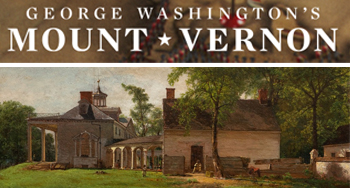
By Sudie Hofmann
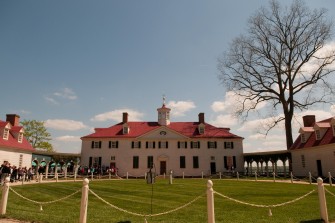
The Mount Vernon estate.
On a beautiful October day I stood in line to purchase a $17 ticket to enter George and Martha Washington’s estate at Mount Vernon in Virginia, joining the more than 1 million annual visitors, many of whom are schoolchildren. As I looked at the large sign on the wall near the ticket booth, detailing the different tours available, I saw a specialty tour—“All the President’s Pups”—and a special Washington dinner tour. I inquired at the information desk in the Ford Orientation Center about the “slavery tour” I’d heard about and I was provided with a daily schedule that indicated the tour began at 2 p.m. I asked if there was any information in the center about slavery that I could read before entering the “mansion house.” The answer was no.
At the time of George Washington’s death, the Washingtons enslaved 318 people of African descent at Mount Vernon, according to the Mount Vernon Ladies’ Association. But you would not know it from the main tour, nor from the brochure. In fact, most visitors, including schoolchildren, can spend hours admiring the Mount Vernon mansion, fine furniture, and manicured lawns without considering that it was all paid for with forced labor.
The introductory brochure highlights several perspectives: George Washington was the ultimate Southern gentleman; he was a state-of-the-art farmer; both Martha and George enjoyed entertaining; life at Mount Vernon provided an idyllic lifestyle, from the grounds and gardens to the mansion house and outbuildings, to the unimaginable comforts of the time. Slavery is mentioned, but only in one section of the brochure, which directs visitors to the Slave Memorial and Burial Ground.
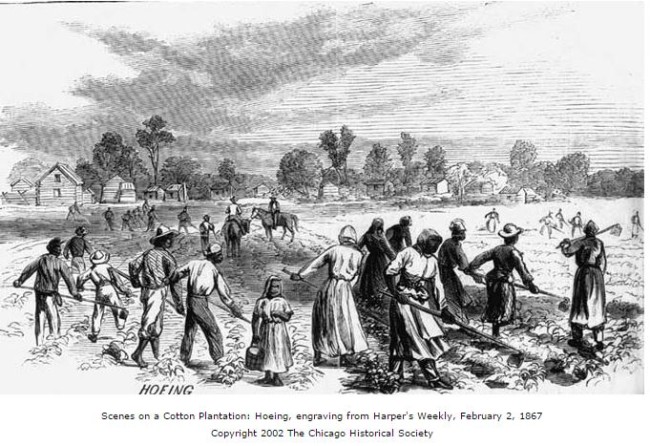
Scenes like this one (while not Mount Vernon) are representative of daily life on many plantations, yet missing from the tour and brochure.
Who Was George Washington?
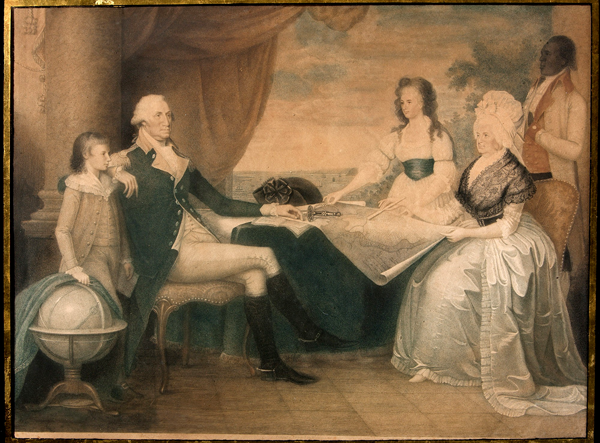
The Washington family. Source: Edward Savage, MtVernon.org.
George Washington is one of the most celebrated war heroes in U.S. history and served as commander in chief of the Continental Army during the American Revolution. He was the first president of the United States from 1789 to 1797. He was also a wealthy land- and slave-owning colonist. His commitment to independence was perhaps motivated more by the opportunities to become even wealthier under independence than an interest in introducing a new concept of democracy to the world. Washington had a lifetime obsession with money, keeping meticulous records of everything he owned, including people.
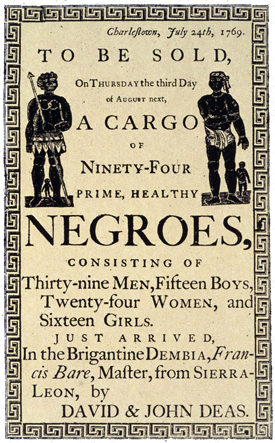
George Washington purchased people directly from the holds of slave ships. He preferred them to be “strait Limb’d & in every respect strong and likely, with good Teeth & good countenances,” not exceeding 16 years of age if female. Washington wanted genetically healthy girls for reproduction purposes.
While serving as president of the United States, Washington faced a legal problem with the people he enslaved. The capital was moved from New York to Philadelphia in 1791 and the enslaved people who accompanied him to Pennsylvania would be given their freedom if they resided in the state for more than six months. George and Martha Washington kept careful records and rotated enslaved people back and forth to Mount Vernon to avoid being required to free any of them.
Mansion House
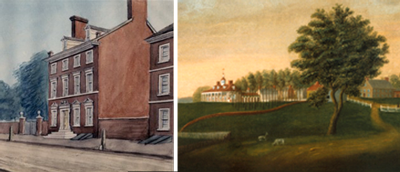
Washington rotated enslaved people between the presidential house in Philadelphia (L) and Mount Vernon (R) to avoid freeing anyone.
Entering the mansion house on the docent-directed tour, visitors were told that the Washingtons loved to entertain. During the first part of the tour, the docent described the food served on elegant china, the dancing that took place and where the men would retire to discuss politics. The docent then escorted visitors through parlors and living rooms where the Washingtons carried out family life and on to the bedrooms on the upper floors where they and their frequent guests slept.
Our tour concluded with George’s study and library and then the docent encouraged us to visit the outbuildings where dairy was processed, fabric was woven, alcohol was distilled, blacksmithing was done, and shoes were made. I use the passive voice here intentionally, because the docent failed to mention the people who actually did this work. When he paused to ask for questions, I asked why there was no mention of the more than 300 people held in bondage at Mount Vernon to make this lifestyle possible. He said, “Oh we make no secret of that. You can visit the slave quarters and find out more about the slaves.” I asked why the tour guides did not mention who performed all the labor when describing the daily activities of the Washingtons. He again directed me to the slave tour and quarters.
Walking Tour—Slave Life
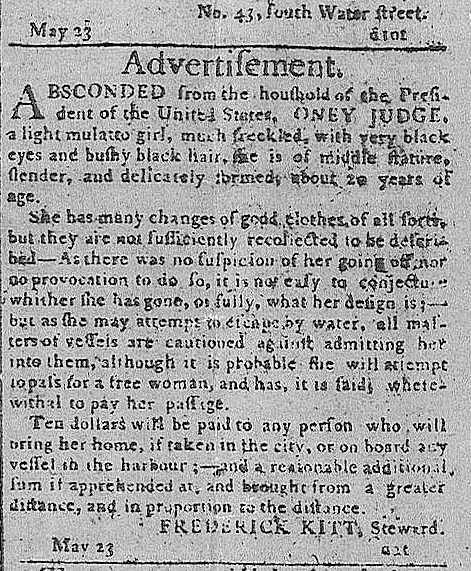
Newspaper ad offering a $10 reward for Oney Judge, who escaped from enslavement by the Washingtons. Click to read text.
A delightful and energetic guide met our group at the Mansion Circle for a 15-minute overview of slavery. The emphasis in this tour, and prevalent throughout the estate, was that the Washingtons were in some ways providing vocational education to the people they enslaved. Returning to the prime motivation for slavery as a profit-making venture, one needs to be cognizant that George and Martha were the ones who reaped the benefits from training enslaved people in certain trades. The profit certainly did not go, in any part, to people held in bondage at Mount Vernon.
Another theme within this tour and the signage throughout the estate was that this was a community of people willingly working toward a common goal, in an almost “whistle while you work” fashion. The astounding inequality was largely ignored. The tour’s narration instead focused on the beauty of the land, the panoramic view over the Potomac, and the warm breezes. The signage and tour create an image of an estate where everyone was happy.
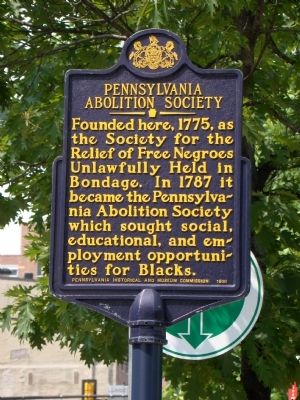
During Washingon’s time, there were a number of groups organized to abolish slavery, including the Pennsylvania Abolition Society.
The guide told tourists that the slaves engaged in trickery with the estate managers when they sang songs in their native languages to warn others that a manager was near. The guide said the slaves would sleep and relax in the shade when no one was around and then the songs would alert them to get up and pretend to be working. He also said, “Slaves could be clever. A new ax could be given to them in the morning and they would make sure to break it by the afternoon. They knew how to get back at plantation owners.” He did acknowledge that there was no “incentive to work” and that being “lazy was OK.” Rather than educating our group about resistance and the need for it, he characterized the men and women as shiftless and conniving.
The guide proceeded to cover the innovative agricultural techniques used on the farm and the high standards Washington demanded. A plaque at the slave quarters states, “The sun never caught George Washington in bed and he was unwilling it should find any of his people sleeping.” At the conclusion of the tour on the front lawn overlooking the Potomac, the guide summarized his message about slavery: “Anyone from the 21st century criticizing someone from the 18th century is being sanctimonious, righteous, and unfair.”
He ignored the fact that during “Washington’s time,” abolitionist groups visited Mount Vernon bearing books and petitions about emancipation, as well as the establishment of manumission societies, humanitarian efforts, writers, and Quaker groups, working to stop the practice of slavery. One needn’t rely on 21st-century critics of slavery; they existed in the 18th century, too.
Slave Cemetery and Memorial
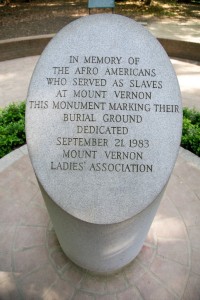
Memorial to African Americans enslaved at Mount Vernon. Source: MountVernon.org.
I walked down a path to the slave memorial and saw a sign asking for “quiet.” I quickly saw that I had entered the area of the Washington family mausoleum. White marble tombs hold Martha and George’s remains. A small crowd of people stood, and listened to the docent’s presentation on George’s family ancestry. There was an aura of awe and respect.
I turned and completed my short walk to the slave cemetery. There was no similar sign that asked for quiet or by extension, respect. Only two other people stood in the area reading the marker designed by Howard University architectural students in 1983. The sign reads “In memory of the Afro Americans who served as slaves at Mount Vernon.” Another grave marker placed in 1929 states “In memory of the many faithful colored servants of the Washington family.” (Italics are my emphasis.)
One has to pause and wonder how the Mount Vernon Ladies’ Association can ethically continue to provide these tours at the estate and mansion house and omit mention of any honest representation of slavery and the contemporary consequences of this institution. They perpetuate the “splendid living” and “Southern hospitality” myth in the face of overwhelming evidence that this is false.
The omission of meaningful education about slavery at Mount Vernon contributes to the general curricular silence about the fact that Washington and other slaveholders like him were stealing land, labor, language, and culture from disenfranchised people on a grand scale.
The Mount Vernon tour prevents critical thinking about U.S. history by reinforcing the traditional narrative about slavery and its legacy. This miseducation continues while collecting millions of dollars at the gate to further the myth.
With all the talk of virtue, morality, and principled values on the tour, is it too much to ask that the truth, the full truth, now be told at Mount Vernon?
© Zinn Education Project, 2015
- Click to email a link to a friend (Opens in new window)
- Click to share on Pinterest (Opens in new window)
- Click to share on Twitter (Opens in new window)
- Click to share on Facebook (Opens in new window)
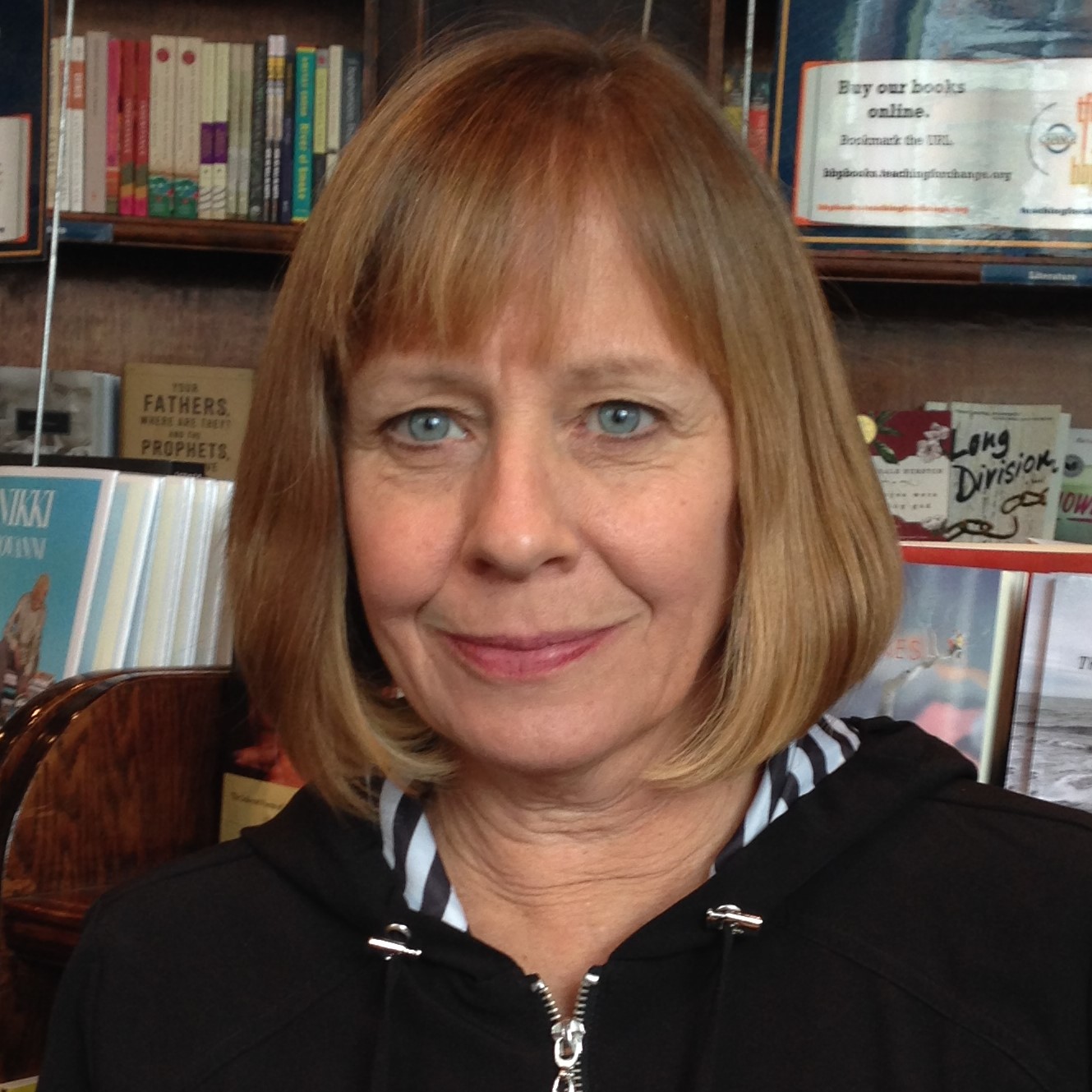
Sudie Hofmann is a professor in the Department of Human Relations and Multicultural Education at St. Cloud State University in Minnesota.
Related Resources
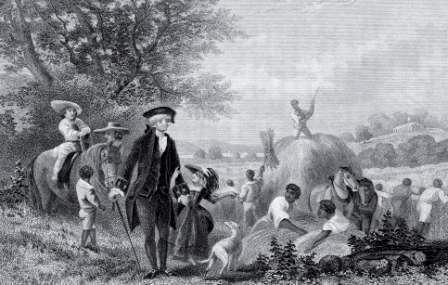
Presidents and the Enslaved: Helping Students Find the Truth
Teaching Activity. By Bob Peterson. Rethinking Schools. 7 pages. How a 5th grade teacher and his students conducted research to answer the question: “Which presidents owned people?” Available in Spanish.
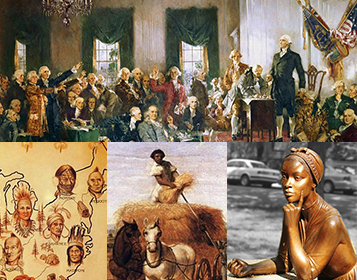
Constitution Role Play: Whose “More Perfect Union”? and The Constitutional Convention: Who Really Won?
Teaching Activity. By Bill Bigelow. 24 pages. The U.S. Constitution endorsed slavery and favored the interests of the owning classes. What kind of Constitution would have resulted from founders who were representative of the entire country? That is the question addressed in this role play activity.
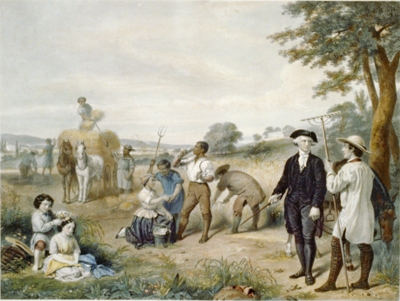
Missing from Presidents’ Day: The People They Enslaved
Article. By Clarence Lusane. 2014. If We Knew Our History Series. Textbooks erase enslaved African Americans from the White House and the presidency and present a false portrait of our country’s history.
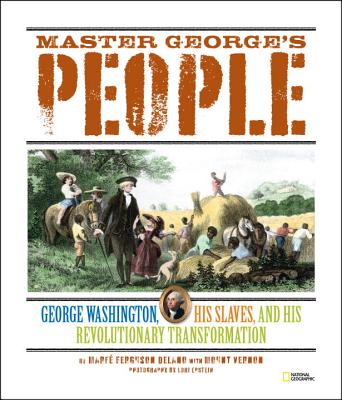
Whitewashing Our First President
Article. By Clarence Lusane. 2014. Critical review of an upper elementary non-fiction book about George Washington and the people he kept in bondage.
The Black History of the White House
Book — Non-fiction. By Clarence Lusane. 2010. 544 pages. The untold story of African Americans in the White House from the 18th century to the present, including the presidents who held people in bondage.
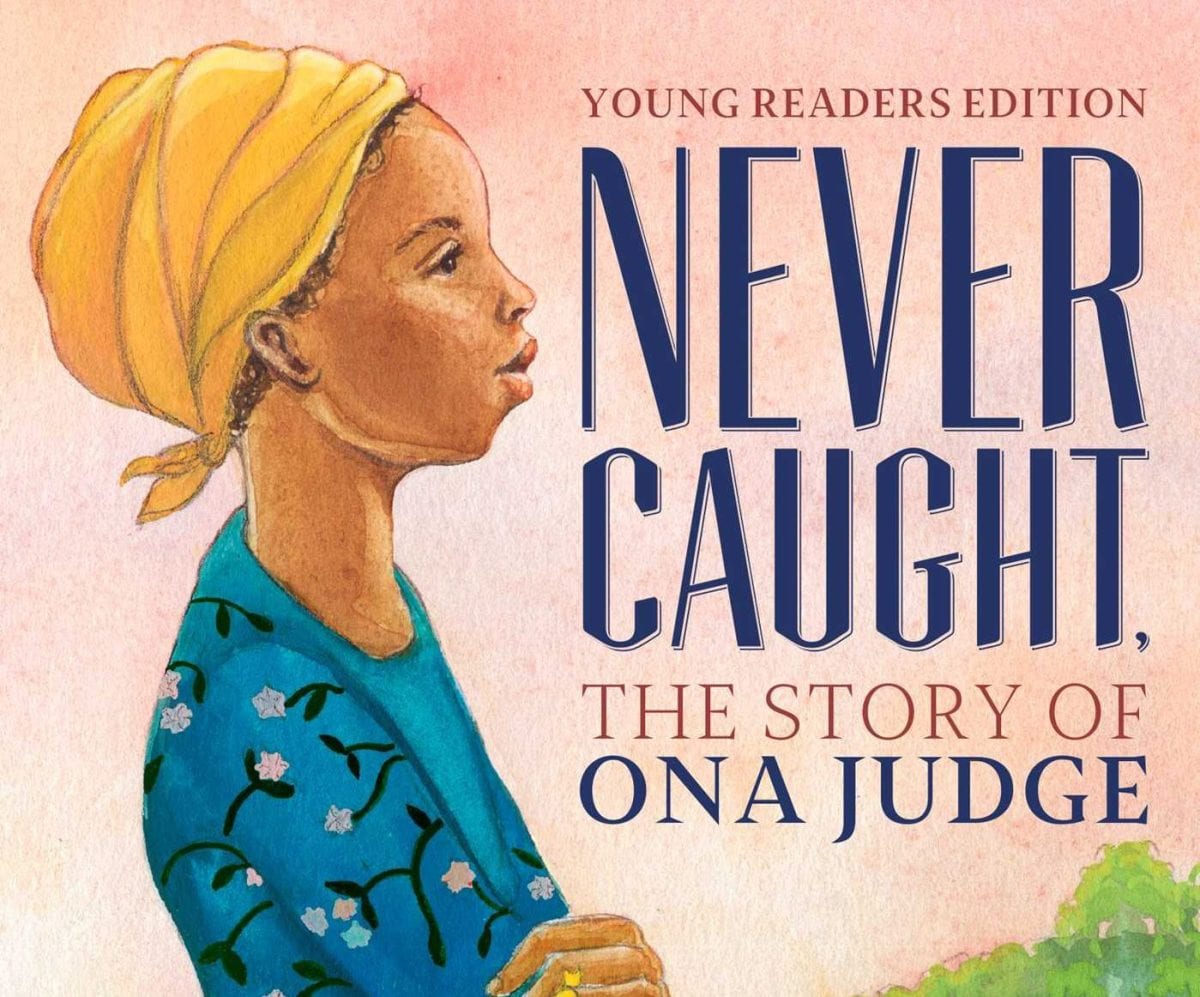
Never Caught: The Story of Ona Judge
Book — Non-fiction. By Erica Armstrong Dunbar and Kathleen Van Cleve. 2019. 272 pages. This is the true story of Ona Judge who escaped from enslavement by George and Martha Washington.
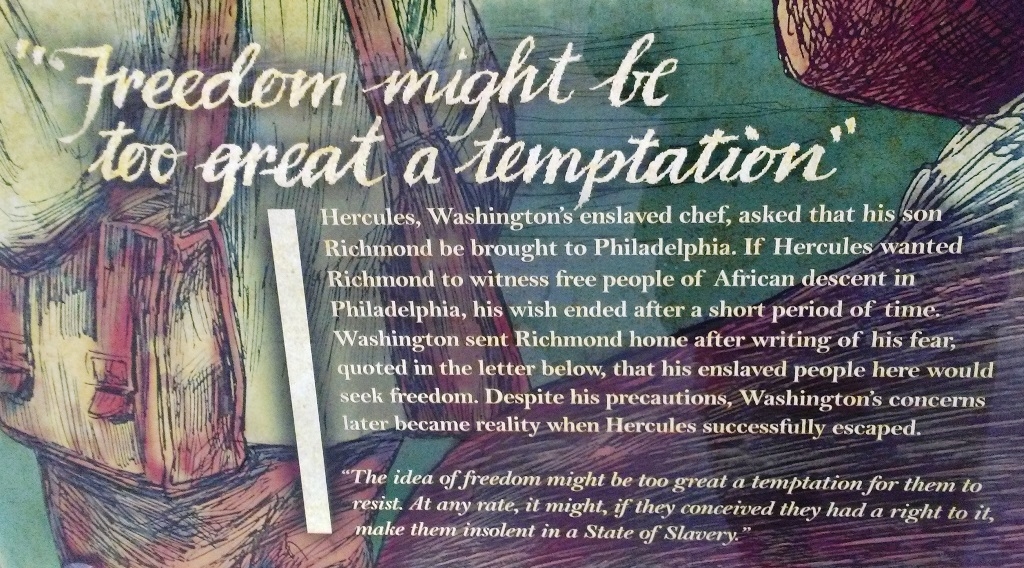
Feb. 18, 1797: Hercules Escapes from Enslavement by George Washington
Hercules, the head cook at George Washington’s Mount Vernon estate and slave labor camp, escaped to freedom in Pennsylvania.
17 comments on “ Time to Tell the Truth About Slavery at Mount Vernon ”
Jen, Hello. I see you visited Colonial Williamsburg in January 2016. I’m thinking that the scarcity of diverse people to be seen at this time or people in general, was due to our pause for employee training. Ordinarily we would have had a lot of folks on layoff at this time, however this year we had foundation wide training and structural management changes as well. However even in full swing we don’t operate showing this town as it would have been peopled day to day. Though we are few in number we are strong in purpose. Please come back and visit again. Go into our trade shops, houses, taverns and listen to put interpreter, if you don’t hear what you were in search of, ask, ask, ask. Go to the Randolph House, the Wythe house, the James Geddy House. Go to the Capitol and Palace and ask about the half of the town who were enslaved and Expect to hear about those people. Ask about the few free blacks who walk the streets there. Ask about evening programming depicting their presence here. Programs such as African American Music, Papa Said, Mama Said, and Affairs of the Heart. Go to the Dewitt Wallace Museum and ask to be shown what represents this part of the population. Also feel free to look for me, Janice Canaday, Adam Canaday, Hooe Wright, Katrina Lewis, James Ingram, Emily James and others who would be happy to assist you in a mire inclusive tour.
Thank you for this article — I just visited the South and returned ever-so-puzzled by the thriving wedding industry on former plantations — all those brides posing for joyous photos seems analogous to an Auschwitz nuptial Albeit Macht Frei.
It is time to examine with a critical eye if the American revolution was more of a self servicing effort by Washington, Jefferson, and Madison to maintain their vast properties and the means to do so (slaves), than the creation of an equalitarian government. England, had forbidden the expansion of slavery and the colonies were already coming under pressure to conform to English law. Current to the times, especially in New England states, there was already an abolitionist movement in place. Our founding fathers could not (anymore than the Confederacy) attempt to stand on traditional values, i.e. slavery, and then espouse the principals of the Constitution. The Constitution is a moral philosophical document – the institution of slavery is not. Either we admit that to espouse both democracy and slavery at the same time is sociopathic behavior, or we admit that greed and selfishness are to be found at both Mount Vernon and Wall Street – past and present.
Thank you for this thoughtful piece. I felt the exact same way on a recent visit to Williamsburg, Virginia. There is one empty building at the edge of Colonial Williamsburg dedicated to African American religion, and supposedly their street theatre includes enslaved people. Considering that 52% of Williamsburg population were enslaved, this is FAR too little.
This article confirms my own impressions over many years of touring the founding fathers’ homes in VA, and in other states. There is an embarrassment and hostility expressed about these people owning human beings. I guess progress is coming slowly as they are now actually admitting that they were slaves, and no longer using the euphemism of “servants” when discussing them on the tours, which they only do when asked. I always ask. At Woodrow Wilson’s home in VA, there is substantial covering up about the slavery Wilson was raised around and the “servants” who were owned by the property. Given that he was a 20th century president, the argument does not hold up that these are 18th and 19th centuries practices. Montpelier is actually reconstructing slave buildings near the “big house.” Much is made about Washington freeing his slaves upon his death but nothing is said about the reason for doing so, taxation for Martha being the cause.
I was a tour guide at Mt Vernon many years ago. They’re hourly workers with absolutely no authority over the content of the tours. There wasn’t a script when I worked there, but there was a clear outline of what topics to include when. It’s a shame you decided to give one of them a hard time instead of addressing it to people who actually make the decisions.
We cannot judge the present by the past, anymore than we can judge what happened in America in the past. The times now are very different and that came about by gradual change. Thus, it is our duty to carry on the job of making our socirty a better one that yesteryear!
Maryann, its beyond perhaps, its a certianty that the truth about Georges slave holdings was buried from the eyes of history.
I don’t think it’s “guilty conscience,” Maryann, but rather perpetuating the myth for power and profit.
Another reference: The Half Has Never Been Told: Slavery and the Making of American Capitalism by Edward E. Baptist
Very enlightening article. I wish that history as is taught in most schools was not one-sided. We may never know the full truth of what awful things were done to people of color, whether African or Native American. Perhaps people with a guilty conscience buried the truth.
Tiffany and Jim, the point of the article escapes you. On second thought, it does not. You conveniently ignore that ugly, painful part of American History, and all the benefits America reaped from such slave policies are white washed from the tour. But this is what many Americans do: turn away shamefully, and pretend everything is OK.
God bless you for writing this article. I plan to read it to my children. The Zinn Education Project is a must have for anyone teaching their children history. I have never visited the Mount Vernon house because I could not bring myself to pay to tour a place where my ancestors were enslaved. Imagine if I had paid and then heard the docent characterize the enslaved African people as “lazy!”
The Mount Vernon website offers in-depth information on various subjects. Including slavery. There are details on those enslaved & on Washington’s changing opinion of slavery. Do investigate. This informative website is partly supported by admission to Monticello.
You failed to mention that George Washington freed his slaves in his will. Those too old or ill to work would be supported throughout their lives; young men would get education & further training to become free Virginians. Alas, slaves that Martha had inherited from her first husband & their descendants could not be freed–they went to her heirs at her death. Alas, the Custis heirs did not share Washington’s beliefs.
Neither did the three of the next four presidents who were also Virginia slaveholders. Washington had hoped to set an example, but Jefferson, Madison & Monroe never freed their slaves. Well, TJ let a few of the Hemings family leave. Jefferson forgot some youthful anti-slavery opinions as he aged–thinking that freed slaves could only be sent outside the US. Which was all too expensive.
I remember this tour well. I went with my Girl Scout troop. It was mid 60’s and it was the first time I saw slave quarters. I was 10 or 11 and was shocked that George had slaves. The ancestors of that place spoke to me, I didn’t want to leave. I saw them running around, working, hauling, getting beat… I wouldn’t leave, they had to come back to get me; everyone was waiting on the bus… It was then that the full impact of institutional racism really hit me. That summer changed my life.
I agree with your commentary however, I think your scope for the tour my exceed the limits of the physical tour to the Slave Courts at Mount Vernon. To supplement, they do offer many courses and seminars.
What is missing is history of where the slaves were from and their names. As property there must have been records of the people that Washington brought off the ships.
Congress should fund the research on identifying the people that were Washington’s slaves.
Comments are closed.

Your browser is not supported for this experience. We recommend using Chrome, Firefox, Edge, or Safari.
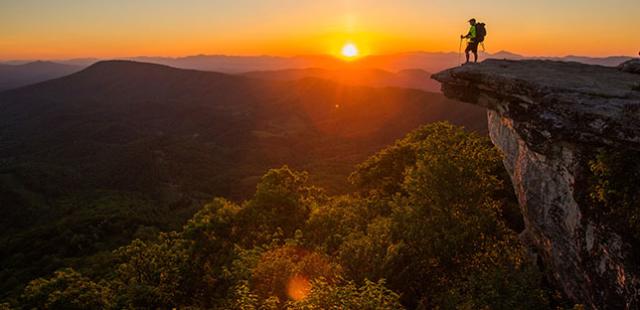
visitors guide
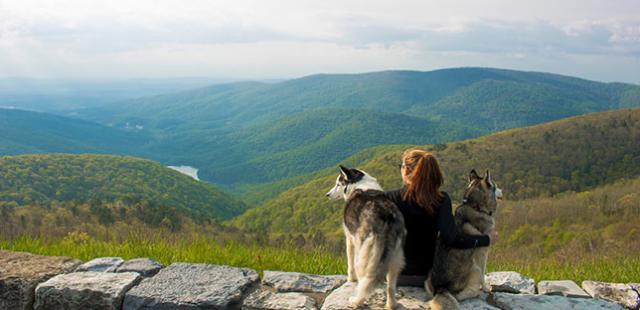
Sign up for our
Enewsletter.
In a Groundbreaking Exhibit at Mount Vernon, Slaves Speak and History Listens
Life at the home of George Washington is told anew
/https://tf-cmsv2-smithsonianmag-media.s3.amazonaws.com/accounts/headshot/SEG_Headshot.jpeg)
Sara Georgini
:focal(1050x750:1051x751)/https://tf-cmsv2-smithsonianmag-media.s3.amazonaws.com/filer/6c/f2/6cf20d1e-93bd-4a62-be2f-67aab3277996/ct-5831_h-2445b.jpg)
You are dining with the President. Frank Lee, standing tall in his red-and-white livery, takes your note of introduction in Mount Vernon’s entry hall. The enslaved butler chooses a spot for you to wait–either in the elegant, robin’s egg blue front parlor , or in the cozier “ little parlor ”–while he alerts George Washington and wife Martha to your arrival.
As the opal haze of a July afternoon rolls off the nearby Potomac River, Lee’s wife, Lucy, labors alongside another enslaved cook, Hercules, to ready dishes for the 3:30 p.m. dinner. Frank, with the aid of waiters Marcus and Christopher Sheels , serves your meal. Around 6 o’clock, they wheel out a silver hot-water urn , and you adjourn to the portico for coffee, tea and conversation with the first family.
Above, in a guestroom, enslaved housemaids, like seamstresses Caroline Branham and Charlotte , go about the last tasks of a day begun at dawn. They carry up fresh linens and refill water jugs. Mount Vernon’s enslaved grooms make a last check on the horses.
This was how English architect Benjamin Henry Latrobe likely experienced his July 16, 1796 visit to Washington’s estate. During his stay, he sketched the grounds and the people with customary fervor. In Latrobe’s first draft of a painting of his day with President Washington, the silhouette of an enslaved man (possibly Frank Lee) was part of the picture. But in the finished watercolor , he is gone.
Lives Bound Together: Slavery at George Washington’s Mount Vernon , a new exhibit at the Virginia estate, on view through 2018, brings Frank , Hercules , Lucy , and other slaves at Mount Vernon to the fore. It’s a project that has been many years in the making. “Our goal was to humanize people,” says Susan P. Schoelwer , Mount Vernon’s Robert H. Smith Senior Curator. “We think of them as individual lives with human dignity.”
The exhibition centers on 19 of the 317 enslaved individuals who worked and lived at Mount Vernon during the Washingtons’ lifetime. Mining a rare cache of material culture, artwork, farm tools and plantation records, curators partnered with scholars and descendants of the enslaved to retell their shared past through the stuff of everyday life.
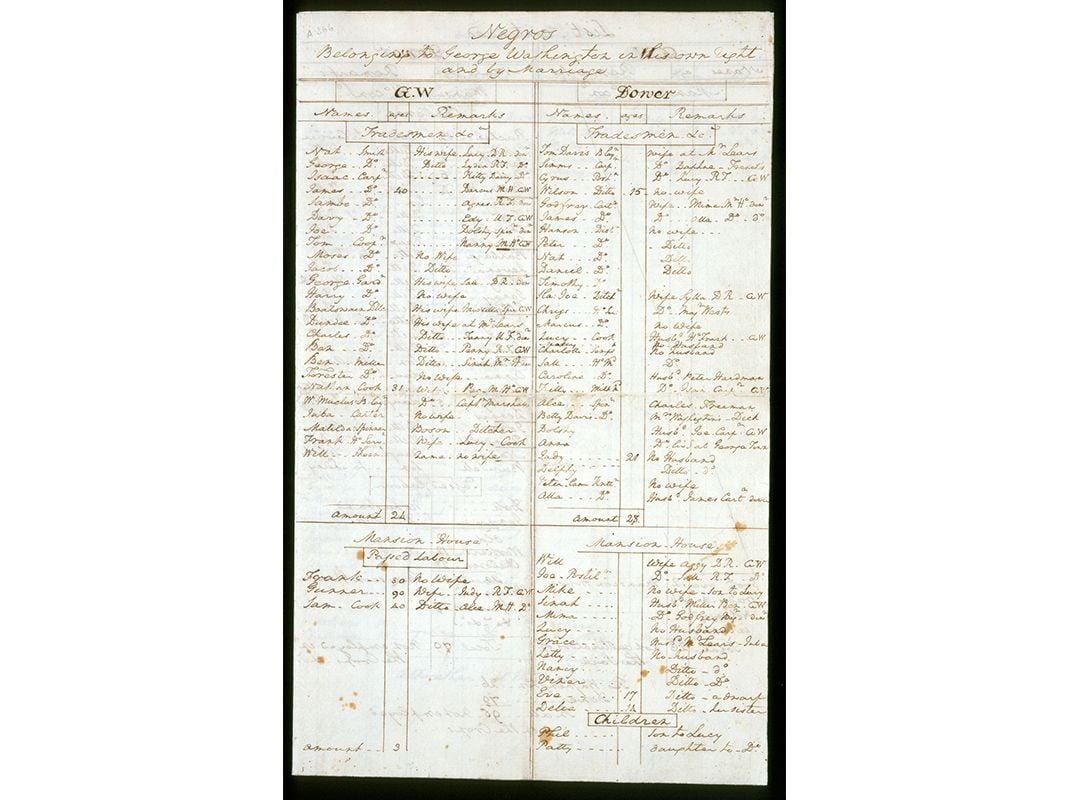
“I know that they are speaking again,” says descendant Judge Rohulamin Quander , a member of one of the oldest traceable African-American families in the United States. “Those voices were unsung up until 1799, and we don’t have any pictures or voice recordings of what they had to say. But they have reached out beyond the grave and said to each of us, we’re depending upon you. You have to do this for us.”
In his 1799 will , Washington included a slave census and a directive to emancipate his slaves. His decision to do so–which Martha promptly carried out–reflects the nearly seven decades the President spent thinking about slavery’s effects on farming and families. Boldly, Lives Bound Together raises a thorny set of questions: What sort of slave owner was Washington? How and why did his thoughts on slavery change?
Records show that George, a slave owner since age 11, brought fewer slaves to his 1759 marriage than Martha. Visitors to Mount Vernon left behind conflicting accounts of Washington’s treatment of his slaves. Whippings and hard labor were frequent forms of reprimand. Yet Washington depended on the enslaved population to take care of his family and secure plantation profits as he took on military and political duties. Often written far from home, some of Washington’s most fascinating correspondence was not with other “founders” but with his farm managers . On New Years’ Day 1789, for example, as the new federal government began to take real shape, Washington turned his attention to Mount Vernon’s needs. He wrote one overseer with clear instructions:
“To request that my people may be at their work as soon as it is light—work ’till it is dark—and be diligent while they are at it can hardly be necessary, because the propriety of it must strike every manager who attends to my interest, or regards his own Character—and who on reflection, must be convinced that lost labour can never be regained—the presumption being, that, every labourer (male or female) does as much in the 24 hours as their strength, without endangering their health, or constitution, will allow of.”
Despite his mounting responsibilities on the national stage, Washington remained a shrewd businessman. He relied on slaves to keep his Virginia plantation running at a profit, says David Hoth , senior editor at The Papers of George Washington editorial project. “He was inclined to suspect his workers of malingering and petty theft, perhaps because he recognized that they probably saw slavery as an unnatural and unpleasant condition,” says Hoth. “He sold at least one runaway to the West Indies and threatened others.”
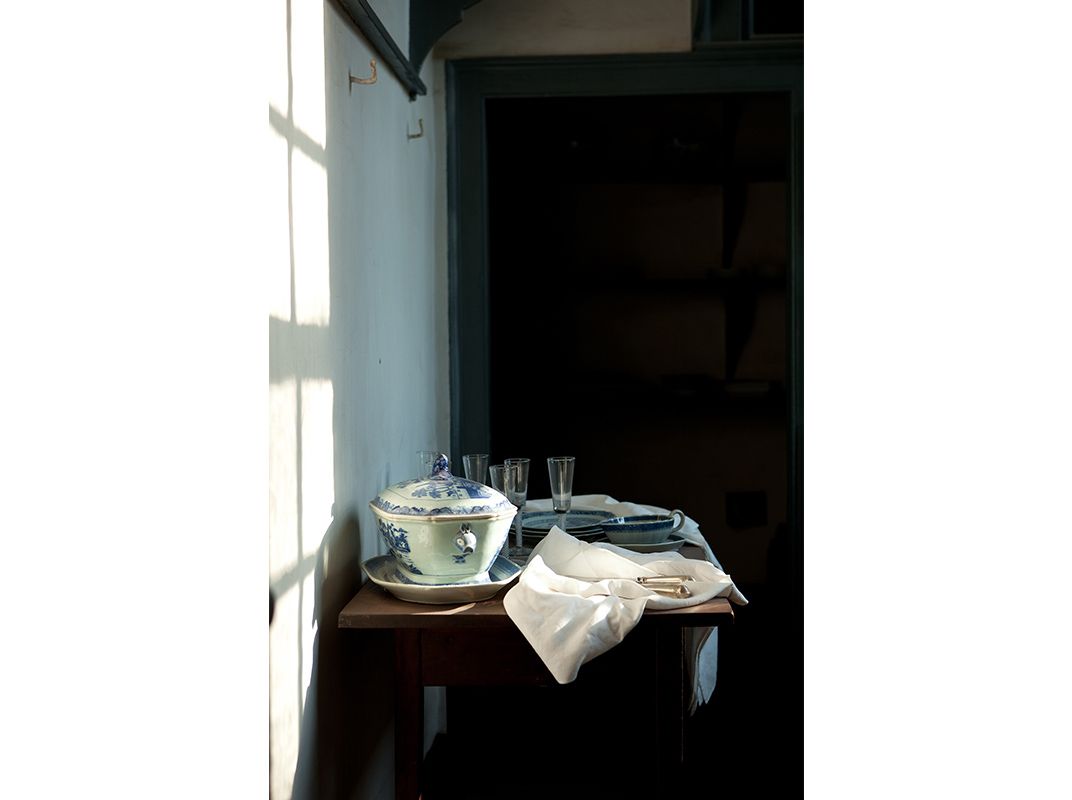
In private, the president came to support gradual abolition by legislative act and favored measures, like non-importation, that might hasten the change. He pursued Mount Vernon’s runaway slaves, albeit quietly, without using newspaper advertisements. By 1792-93, according to Hoth, George Washington began to mull the idea of emancipation.
“It’s important to tell the story of his views on slavery and how they evolved,” says Schoelwer. “He was in the position of trying to balance private concerns with his public commitment to the survival of the nation.” At the same time, he used legal loopholes to make sure his slaves were kept enslaved.
The Mount Vernon exhibit collects a diverse medley of African-American sagas that reconsider the 18th-century world’s understanding of slavery and freedom. Via short biographies, reinterpreted artifacts, and new archeological evidence from Mount Vernon’s slave cemetery, 19 lives emerge for new study. A new digital resource, an ever-evolving slavery database , allows visitors to search Mount Vernon’s enslaved community by name, skill or date range.
So far, the database has gathered information on 577 unique individuals who lived or worked at Mount Vernon up to 1799, and compiled details on the more than 900 enslaved individuals with whom George Washington interacted during his travels, according to Jessie MacLeod, associate curator at Mount Vernon. But though it shows a thriving plantation, the database also tells a different story. “You really get a sense for how often people are running away,” says MacLeod . “There are casual mentions in the weekly reports, of people being absent sometimes for 3 or 4 days. It’s not always clear whether they came back voluntarily or were captured. There’s no newspaper ad, but we do see an ongoing resistance in terms of absenteeism, and when they’re visiting family or friends in neighboring plantations.”
In the museum world, reinterpretation of slavery and freedom has gained new momentum. Mount Vernon’s “Lives Bound Together” exhibit reflects historic sites’ turn to focus on the experience of the enslaved, while exploring the paradox of liberty and slavery in daily life. In recent years, historians at Mount Vernon, along with those at Thomas Jefferson’s Monticello and James Madison’s Montpelier , have rethought how to present those stories to the public through new signage, “slave life” walking tours, and open archeological digs. A series of scholarly conferences--sponsored by institutions like the Omohundro Institute of Early American History and Culture , the National Endowment for the Humanities, the University of Virginia , and many more --have been hosted at the former presidential homes.
Latrobe’s portrait of life at Mount Vernon may have initially included the slaves who made Washington’s estate hum, but the finished painting only tells part of that story, Lives Bound Together completes the picture by depicting the shared journey of the Washingtons and the enslaved. “We helped build this place and make it what it is. We helped make the president who he was,” says Shawn Costley, a descendant of Davy and Edy Jones , in the exhibit’s film. “We might not have had voting power and all that back then, but we made that man, we made George Washington, or added to or contributed to him being the prominent person that he is today.”
Get the latest History stories in your inbox?
Click to visit our Privacy Statement .
/https://tf-cmsv2-smithsonianmag-media.s3.amazonaws.com/accounts/headshot/SEG_Headshot.jpeg)
Sara Georgini | | READ MORE
Sara Georgini is series editor for The Papers of John Adams , part of The Adams Papers editorial project at the Massachusetts Historical Society. She is the author of Household Gods: The Religious Lives of the Adams Family .
- Skip to main content
- Keyboard shortcuts for audio player
George Washington's Mount Vernon Highlights More Stories Of Enslaved People
Esther Ciammachilli

Brenda Parker is the head of African American Interpretation at Mount Vernon. Part of her job includes donning slave clothing and portraying Caroline Branham, a former housemaid. Here she stands in her favorite spot, the slave cemetery. Parker says she comes here to seek solace and sometimes to sing to the ancestors. Tyrone Turner/WAMU hide caption
America's history is being taken to task. People are calling for a reckoning of the violent, racist past that has permeated every facet of society. The legacy of landmarks is being scrutinized for traditionally glorifying the country's white Founding Fathers, many of whom were slave owners and fought to protect the institution of slavery.
So conversations about slavery at Mount Vernon and other historic sites will likely get more uncomfortable as systemic racism and white supremacy in America are being challenged once again. This time with much more fervor.
Brenda Parker's job is to help shape the narrative of the enslaved people at Mount Vernon. Parker, the head of African American interpretation, says the plantation is now focused as much on the lives of the enslaved people as it is on the life of George Washington.
"Because everything, everything was Washington-centric," she says, rapidly pounding her fist into her hand to hammer home her point. "I get it. We're on his property. But if it weren't for us, he would not have had that property."

Brenda Parker interacts with visitors at Mount Vernon as Caroline Branham, one of the enslaved people owned by George Washington. She stays "in character" offering personal observations of what life was like for enslaved peoples at that time. Tyrone Turner/WAMU hide caption
Parker, who's wearing a mask because of the pandemic, doesn't mince words. "Us" is personal to her. As a Black woman, Parker feels a deep, emotional connection to Caroline Branham, the interpretive character she portrays as part of her job. Sometimes, Parker has a hard time separating herself from Branham, a former housemaid. But she slips in and out of character seamlessly.
"You know like if your grandmother gave to you a dog, and that dog did have a litter of puppies. It would be your choice to keep one, sell one, and give one away as a gift. That's how we're thought about," says Parker, as Branham, recalling how she explains to children the way in which enslaved families were torn apart.
Parker switches out of character and continues as herself. "Understandable enough for a child and the adult starts to get a little uncomfortable. But that's fine and that's good because this is uncomfortable."

The bricks that were used to build the slave quarters at Mount Vernon were forged by the enslaved people of the plantation. Some of them left fingerprints in the clay. Parker poses with her fingers in the hardened indentations of her favorite brick — a sort of spiritual handshake. "This was [our] ancestors work. They left us tangible evidence of their existence here. And that's lasting," she says. Tyrone Turner/WAMU hide caption
Stories Of The Enslaved People
What passes as history at Mount Vernon has changed over the years. It's now less about extolling George Washington's virtues and more about how bondage took its toll on those who built and cared for the property. The exhibit Lives Bound Together: Slavery at George Washington's Mount Vernon , does just that.
"We thought that we could tell a story here that was not about slavery as an institution, but the experiences of real people at a particular place. That you could effectively follow in their footsteps," says Susan Schoelwer, executive director of historic preservation and collections at Mount Vernon.
The first thing you'll see when visiting the exhibit is a massive glass entrance emblazoned with the names of hundreds of people formerly enslaved at Mount Vernon. Visible directly through the inscribed glass is a bust of America's first president.
"You see Washington through the names of this community that surrounded him. And, arguably, what Washington accomplished relied upon what they did on an everyday basis," Schoelwer says.

The entrance to Lives Bound Together: Slavery at George Washington's Mount Vernon. Tyrone Turner/WAMU hide caption

The bust of George Washington as seen through the names of the enslaved people that adorn the glass entrance to the Lives Bound Together exhibit. Tyrone Turner/WAMU hide caption

The exhibit features reimagined silhouettes of what formerly enslaved people might have looked like during their time at Mount Vernon. Very few images of the actual enslaved people exist. Tyrone Turner/WAMU hide caption

Susan Schoelwer, executive director of historic preservation and collections at Mount Vernon, points to a map that shows where the 317 enslaved men, women, and children ended up after Washington's death in 1799. Many of them were freed. But others, called dowry slaves because they had belonged to Martha Washington's first husband, were sent to work for family members. Tyrone Turner/WAMU hide caption
Names like Oney "Ona" Judge, whose escape from the plantation became something of a legend among the enslaved population. Judge was Martha Washington's personal maid and was well-known by the Washington's friends. She escaped from Mount Vernon and made her way to New Hampshire where slavery was illegal. A friend of the Washingtons saw Judge on the streets of Portsmouth and sent word to Mount Vernon. This began a long negotiation process between Judge and her former master.
"Washington sent a customs agent to negotiate with Judge saying the Washington's want you back," Anette Ahrens, interpretive supervisor and guide of the Enslaved Peoples tour, told a recent group of visitors. "Surprisingly, Ona said 'Maybe. If he guarantees my freedom after his death.' Washington's response to that was running away showed disloyalty and he wasn't going to reward disloyalty."
A year had passed as negotiations faltered. Washington decided to send his nephew to kidnap Judge. The nephew attended a dinner at the governor's mansion in New Hampshire and told everyone what he was there to do.
"We don't know if it was a guest at the table or one of the free Black servants serving dinner, but someone got word to Ona. So, she laid low," Ahrens tells the group.
Judge's story is the subject of a 2017 biography titled Never Caught: The Washington's Relentless Pursuit of Their Runaway Slave, Ona Judge by Erica Armstrong Dunbar.
Much of the Lives Bound Together exhibit is now available online as in-person visits to Mount Vernon are down significantly due to the pandemic.

This marker in the slave cemetery was placed in dedication by the Mount Vernon Ladies Association in 1929. Notice the outdated language describing the enslaved people. Tyrone Turner/WAMU hide caption
Uncovering Those Lost To History
But nothing you can look at on your screen is going to give you the same feeling as standing where the enslaved people once lived, worked and are now buried. At the south end of the property, shrouded by tall trees is the slave cemetery.
"It is my absolute favorite spot," says Brenda Parker. She inhales deep as if she's breathing in the lingering spirit of these long-lost souls. "I feel at peace here, a solace here as well as a connection to the past. And then every once in a while a breeze might blow through and it's as if God or the ancestors are answering a question or a prayer that I had."
Parker is sometimes even moved to sing to those ancestors.
Right along the shaded cobblestone path leading into the cemetery, just inches from it, in fact, are two rectangular pieces of earth marked with string. They are the graves of formerly enslaved people discovered by ongoing archaeological work. Archaeologists have been working here for about seven years. Mount Vernon curators say they don't know exactly how many people are buried here, but they say about 80 graves have been uncovered so far.
This cemetery is thought to be the final resting place of William "Billy" Lee, George Washington's personal valet, who fought alongside the general during the Revolutionary War. Their relationship was special and is cited as a reason why Washington began to abhor the institution of slavery. Lee was one of the many slaves freed upon Washington's death in 1799. Lee remained at Mount Vernon until his death in 1828.
Lee's story, along with those of Ona Judge, Caroline Branham and many others, put a human touch to one of the most horrific periods in American history. Their lives can help visitors to Mount Vernon gain a more nuanced understanding of how we got to this current moment of racial reckoning, which is needed to move forward.

Brenda Parker playfully staring out at the Potomac River on the east front of the mansion house at Mount Vernon. Tyrone Turner/WAMU hide caption
Correction Aug. 6, 2020
An earlier version of this story said the Lives Bound Together exhibit opened in 2020. The exhibit opened in 2015.
© 2024 WAMU
Questions or comments about the story?
WAMU values your feedback.
- Contact the station
Encyclopedia Virginia, Virginia Humanities

Enslaved Community at Mount Vernon
George Washington ‘s Mount Vernon estate relied on the labor of enslaved Africans and African Americans to power its five distinct farms: Mansion House Farm, River Farm, Dogue Run Farm, Muddy Hole Farm, and Union Farm. Washington acquired these men and women through inheritance, purchase , natural increase, and his marriage to Martha Dandridge Custis. At the height of its development under Washington, the estate was home to more than 300 enslaved people of African extraction; compare this to the roughly 30 residents of European extraction, which includes members of the Washington family, their managerial staff, and hired and indentured craftsmen , together with their families. Washington was, thus, living in the midst of a large African and African-American community. Most of what we know about the enslaved community at Mount Vernon comes from records kept by the white people in their lives, as well as archaeological finds. Perhaps the most valuable written records of this community are the two sets of slave inventories that Washington prepared in 1786 and 1799. From the demographic information in these lists, historians have reconstructed extended multigenerational families. Enslaved men and women at Mount Vernon worked from Monday to Saturday as skilled or field laborers, sometimes resisting their enslavement by escaping , by committing theft or arson, or through more passive means. In their spare time, they formed friendships, found love and got married, had children, cared for their homes and families, and maintained diverse religious practices. During and after the American Revolution (1775–1783) Washington’s views on the morality of slavery evolved, and he stopped buying and selling people. The enslaved community at Mount Vernon began to dissolve in 1801 as a result of Washington’s death and his directions about manumitting his slaves in his will .
Growth of a Community

These enslaved men and women formed a community, building friendships and families. As a result, the enslaved population at Mount Vernon increased steadily, even late in the eighteenth century, when Washington’s views on slavery shifted and he stopped actively acquiring slaves. (He wrote in 1786, for example, that “I never mean (unless some particular circumstances should compel me to it) to possess another slave by purchase.”) The historians Philip D. Morgan and Michael L. Nicholls estimate that over the course of his lifetime, Washington owned or managed about 670 slaves. By the time of his death in 1799, there were more than 300 enslaved people at Mount Vernon.
Sources for Information About Slavery
Archaeological remains of enslaved life at mount vernon.

Because very few of those enslaved at Mount Vernon could read or write , the sources scholars use to learn about them come primarily from records kept by the white people in their lives. These sources include diaries, correspondence, and work reports kept by the Washingtons, their friends and family members, their farm managers and overseers, and the many visitors who came to Mount Vernon each year. These documentary sources are sometimes corroborated by archaeological finds, which shed light on the material objects used and owned by those who were enslaved. For example, written sources indicate that certain slaves at Mount Vernon were provided with guns and shot to supplement their diets and to furnish the Washingtons’ table with fresh game. Archaeologists working in the cellar of a Mount Vernon slave quarter found lead shot and gunflints from the same period, reinforcing that documentation.

Perhaps the most valuable written records of the enslaved community at Mount Vernon are the slave inventories that Washington completed in 1786, after he had returned from the Revolutionary War, and in 1799, as he created his last will and testament. In both sets of lists, Washington named each person on his five farms and gave an idea of their age and the kind of work they did. There were notes on whether someone was too old or infirm to work. If the person was a child, he recorded the name of his or her mother. On the two 1799 lists, Washington recorded the name and residence of each adult’s spouse, if applicable, and the spouse’s owner. From the two sets of lists, historians at Mount Vernon have reconstructed extended multigenerational enslaved families.
Demographics

Washington’s lists provide a wealth of demographic information about these men and women. For example, because Washington noted which men and women he owned outright and which were Custis dower slaves, historians have been able to deduce their backgrounds. According to the historian Lorena S. Walsh, about one-third of the working adult slaves owned by Custis were born in Africa, while the remainder, as well as the children, were the American-born descendants of people captured decades earlier in the Bight of Biafra, West Central Africa, Angola, and the Gold Coast. Having spent years in Virginia, they probably spoke English and were familiar with the ways of Anglo-Virginian culture. Walsh indicates that the slaves Washington inherited were primarily Africans, as were those he acquired directly from ships bringing them to America , most likely from Senegambia. Those he got from estate sales were primarily either Africans who had been in Virginia for a while or they were Virginia-born, a generation or two removed from the ships.

Both African and European religious influences could be found among the enslaved community at Mount Vernon. Some men and women had religious practices that were influenced by African traditions like Vodoun or Islam. Others may have participated in local, organized Anglican, Baptist, Episcopalian, Methodist, or Quaker congregations. The community also developed at least one spiritual leader of its own. Caesar, a Custis family slave from Union Farm, was a well-known preacher among the local black population in the last years of the eighteenth century. According to a runaway slave advertisement from 1798, “[in] the neighborhood he is so well known as to need no further description, for he frequently reads or preaches to the blacks.” The advertisement also recorded that he usually wore clothing of black and white homespun, a combination that probably related to his role as a minister.
Washington’s summer 1799 lists also reveal important information about the ages and occupations of the men and women who lived at Mount Vernon. The 1799 lists indicate that 184 of the enumerated 316 slaves were of working age and that, of these, a little over one-quarter were considered skilled laborers. They worked as blacksmiths, carpenters, coopers, gardeners, millers, distillers, bricklayers, postillions, cart drivers, and shoemakers, as well as spinners, seamstresses, dairy maids, cooks, housemaids, and butlers. The majority of these skilled workers were male and lived at the Mansion House Farm, without their families. Almost three-quarters of the enslaved workers labored in the fields; most of them lived on the outlying farms, and well over half of these, or 61.4 percent, were women.

Of the slaves recorded on the 1799 lists, 42 percent were either too young or too old to work. Further analysis of the information on ages shows rapid growth in Mount Vernon’s enslaved population. In the thirteen years between the completion of the 1786 and 1799 lists, the population had increased by 100 people, during a time in which Washington was not actively acquiring slaves. Therefore, this increase can be almost completely attributed to natural growth—that is, children born to enslaved men and women on the estate. According to the 1799 lists, the average age of a slave on the four outlying farms was about twenty-one years. Only a little more than 8 percent of the people were older than sixty, while more than 58 percent were younger than nineteen. Nearly 35 percent of the total population of the outlying farms were children younger than nine. All of this increase was the outgrowth of Washington’s stated abhorrence to breaking up families and to selling slaves, as he put it , like “cattle in the market.”

Marriage was a basic building block of the enslaved community at Mount Vernon. While the Washingtons acknowledged these marriages, the unions were not recognized or protected by the legal system: slaves were considered property, not people, in the eyes of the law, and property cannot enter into a contract. Roughly two-thirds of the adult slaves at Mount Vernon were married in 1799, but of those ninety-six individuals, only thirty-six lived in the same household as their spouse and children. Another thirty-eight had spouses who, because of work assignments, lived on one of Washington’s other farms, while twenty-two had married people from other plantations. In other words, almost two-thirds of the married couples at Mount Vernon had long-distance relationships. These figures also suggest that there was time and opportunity for enslaved men and women to meet the enslaved residents of other plantations and members of the free black community and decide they wanted to be married.

The 1799 slave lists tell us something else about family life at Mount Vernon—almost three-quarters of the children lived in households headed, at least during the work week (Monday through Saturday), by single parents, who were almost always mothers. This means that many women, after putting in a grueling day in the fields—where they might be plowing, hoeing, or building fences from dawn to dusk—then came home to hungry children, who had to be fed and tended to, as well as household chores, without the support or protection of a spouse. It also suggests two other things: First, that older children probably had a lot of responsibility placed on them by this exhausted parent, who needed them to look after younger siblings, weed the family garden, feed the chickens, and haul wood and water to the cabin. Second, that they also were relatively unsupervised during the day, except by other children, which meant that they could get into a lot of mischief, something Washington complained about in his letters.
Romanticized Views of Enslavement at Mount Vernon

Like many other planters, Washington connected the success of his farms with the productivity of his enslaved workforce. He managed his farms with an eye toward maximizing profit. As a slave owner, he authorized severe punishments against the enslaved population, including whippings and the threat of harsher work assignments. And before he decided to disengage from the slave trade, he could sell an unruly slave to a buyer outside of Virginia, effectively exiling the enslaved man or woman from their family and friends at Mount Vernon. Even later, he could send an unruly slave to be sold in the West Indies, with the same effect. In the meantime, he fed, clothed , and housed his slaves in accordance with the practices on other large plantations.

Men and women resisted their enslavement at Mount Vernon in a number of ways. Some ran away in an attempt to become free; for example, in 1781, seventeen enslaved men and women boarded the British warship the HMS Savage , then anchored in the Potomac River. Some of the men and women who successfully escaped worked closely with the Washingtons. Oney Judge , Martha Washington’s personal attendant, ran away in 1796, later citing her “thirst for compleat freedom”; Hercules , the family chef for at least ten years, escaped in 1797. Washington’s personal waiting man, Christopher Sheels, also planned to escape with his wife in 1799 but was discovered before he could carry out the attempt.
More subtle means of resistance included misplacing or damaging tools and equipment, feigning illness, producing work of poor quality, or slowing the pace of work. For example, Washington once commented that the plantation’s wagons seemed to go off and “go to sleep.” Others resisted by committing arson or theft.
The Breakup of a Community

Washington’s views on the morality of slavery evolved over time. During and after the American Revolution, his private statements about slavery began to align with abolitionist goals, and he stopped buying and selling people. But the enslaved population at Mount Vernon continued to grow through natural increase. By the last year of his life, 1799, Washington had serious concerns about the viability of the operation at Mount Vernon. In a letter to his nephew, Robert Lewis, he noted that he had “more working Negros by a full moiety, than can be employed to any advantage in the farming System.” In other words, he had twice as many workers as he needed, and there was a rapidly rising younger generation growing up in the quarters, who would soon reach working age.
Where someone else might have sold off the surplus people, he explained that he was “principled against this kind of traffic in the human species.” He found the prospect of renting people out to others “almost as bad, because they could not be disposed of in families to any advantage, and to disperse the families I have an aversion.” He went on to confide his worries, “What is then to be done? Something must or I shall be ruined.” He closed with an idea he was mulling over of sending the extra people to work the land on some of the thousands of acres he owned around the country. “But where?”

At around the same time, Washington drew up his last will and testament. He directed that all 123 of his slaves be freed. His longtime valet William Lee was to be freed immediately upon Washington’s death, while the others were to be freed upon the death of Martha Washington. Washington knew that manumitting his slaves would result in the enforced separation of families in which Washington slaves and Custis dower slaves had intermarried, and he hoped to spare himself and his wife from witnessing it.
But Martha Washington freed the Washington slaves on January 1, 1801, about eighteen months before her death—perhaps uncomfortable with the idea that her death would be the catalyst for freedom for so many. This led to the breakup of twenty families. The Custis dower slaves were divided among Martha Washington’s four grandchildren after she died in 1802. Bushrod Washington, George Washington’s nephew and an associate justice of the U.S. Supreme Court , inherited Mount Vernon.
- African American History
- Revolution and Early Republic (1763–1823)
- MacLeod, Jessie and Mary V. Thompson. Lives Bound Together: Slavery at George Washington’s Mount Vernon . Mount Vernon, Virginia: Mount Vernon Ladies’ Association, 2016.
- Morgan, Philip D. and Michael L. Nicholls. “Slave Flight: Mount Vernon, Virginia, and the Wider Atlantic World.” In George Washington’s South , edited by Tamara Harvey and Greg O’Brien. Gainesville, Florida: University Press of Florida, 2004.
- Walsh, Lorena S. “Slavery and Agriculture at Mount Vernon.” In Slavery at the Home of George Washington , edited by Philip J. Schwarz, 46–77. Mount Vernon, Virginia: Mount Vernon Ladies’ Association, 2001.
- Wiencek, Henry. An Imperfect God: George Washington, His Slaves, and the Creation of America . New York: Farrar, Straus, and Giroux, 2003.
- Name First Last
- Name This field is for validation purposes and should be left unchanged.
Never Miss an Update
Partners & affiliates.
Encyclopedia Virginia 946 Grady Ave. Ste. 100 Charlottesville, VA 22903 (434) 924-3296
Indigenous Acknowledgment
Virginia Humanities acknowledges the Monacan Nation , the original people of the land and waters of our home in Charlottesville, Virginia.
We invite you to learn more about Indians in Virginia in our Encyclopedia Virginia .

Mount Vernon Slave Tour: A Perspective On History
MOUNT VERNON, Va. - For generations, George Washington's impressive mansion on the Potomac River has stood as a memorial to the man who carved a plantation and a new nation from the wilderness of early America.
Left out of the story until now were the people whose sweat and bondage made the plantation possible - the slaves.
This spring their presence returned to the estate near Washington, D.C., in the form of a new daily tour, "Slave Life at Mount Vernon."
Half-hour walking tours introduce guests to the 316 slaves who lived at Mount Vernon at the time George Washington died in 1799. The mansion farm was home to about 90 of them.
During the past 20 years, as interest has grown in slave life, Washington's meticulous records and archaeological digs around the estate have changed some perceptions about the slaves at Mount Vernon, said Dennis Pogue, Mount Vernon archaeologist.
A former trash pit at the greenhouse slave quarters offered two surprising finds:
Trash from the slaves looks surprisingly like trash from the main house. "They were living so close to the mansion and were house servants and craft people," Pogue said. "So much of their material looks like it was handed down from the Washington family."
Slaves who worked in the fields probably had much less.
Bones and shells from 53 different animals indicate that slaves were able to vary their daily ration of cornmeal and dried fish by hunting and fishing. "Their diet was probably better than we thought because of the diversity," Pogue said.
Remnants of clay marbles, jaw harps, pipes and possibly pieces of toys give an idea of things that might have been available for enjoyment.
Washington inherited his first slaves when he was 11 years old. Before the Revolutionary War, he stopped buying and selling slaves. He recognized slave marriages, even though state law didn't, and kept family units together.
"This was the society he grew up in," said Paula Sisco, historic interpreter. "He and a lot of others became uncomfortable with it. By the end of his life, most of his slaves had been born here."
In his will, he promised freedom to his slaves when his wife died. Martha Washington actually freed them only a year later.
"People often ask us whether we think Washington was a good slave owner," said Marilyn Sobke, Mount Vernon spokeswoman. "Was there any such thing as a good slave owner? Slavery was a fact of life, but slavery was still slavery. The plantations needed the labor force. They could not survive without a huge labor force."
The complexity of slavery surfaces in the stories of people like Hercules, the cook, and Charlotte, a spinner.
When Hercules went with the Washingtons to Philadelphia during the first president's term of office, the slave was allowed to make money by selling presidential leftovers and cooking for other families in his time off. He used some of that money to dress like a dandy in silk and velvet, with buckles on his shoes and a gold-headed cane.
Soon after the Washingtons returned to Mount Vernon, Hercules escaped. A foreign visitor remarked to Hercules' 6-year-old daughter that she must be sad not to see her father.
"She said, `Oh, sir. I am very glad because he is free now,' " Sobke said. Even a child knew what bondage meant.
Charlotte was owned by Martha Washington, as were more than half of the slaves. While the Washingtons were away, Charlotte helped out with the hog killing and asked the overseer for a spare rib - the usual payment. He refused to give it to her until later, and when she finally got it she followed him home and threw it at his door. He whipped her. She protested that she hadn't been whipped in 14 years.
Living conditions for slaves, though harsh and primitive, likewise weren't that different from the working classes in the 1700s, said Billie McSeveney, interpretive supervisor.
Slaves, however, had no chance to improve their condition as life improved in the 1800s for the white middle class. ----------------------------------------------------------------- If you go
Slave life tours are offered daily at 10 a.m., noon, 2 and 4 p.m. Mount Vernon is open from 8 a.m. to 5 p.m. April-August, and from 9 a.m. to 5 p.m. September-March. Admission is $7 for adults, $6 for senior citizens and $3 for children ages 6 to 11. Information: (703) 780-2000.

Go: Mount Vernon’s “Enslaved People’s Tour”…
Share this:.
- Click to share on Facebook (Opens in new window)
- Click to share on X (Opens in new window)
e-Pilot Evening Edition
- Things to do
Things To Do Travel
Go: mount vernon’s “enslaved people’s tour” provides haunting enlightenment.

My wife, Carol, and I had come to Mount Vernon to participate in the “Enslaved People’s Tour,” at the Mansion House Farm, site of George Washington’s iconic home. At the time of his death in 1799, Washington owned several plantations all dependent on the labor of hundreds of enslaved people. What we know today about them comes from a mixture of archaeology, George Washington’s voluminous record keeping and oral tradition.
Standing at the circle in front of the mansion, Brown explained that George Washington designed his home, and designed the grounds, but it was the enslaved people who did the physical labor. He had a master builder, “but enslaved men built that house,” she said.
The house today looks as it did in 1799. Our view of the mansion was marred by scaffolding covering the western side as workers made repairs and repainted it in its original cream color. The rhythmic tapping of hammers played out as we watched a job that slaves once would have done.
On the day of our visit, the weather was unseasonably cold with a bitter wind. I asked how enslaved people working the fields would be dressed on such a day.
“They were provided with two sets a clothing — a winter set and a summer set,” Brown said.
The summer set was linen, including a shift for both sexes, a jacket and a pair of trousers for the men and skirt for the women. The winter garments were similar, but made of wool. They received one pair of shoes a year. Field slaves would soon find themselves clothed in tatters. It wasn’t hard to imagine how miserable those ill-clothed people must have been, especially on a day like today.
Household slaves were usually mixed race and wore better clothes than their counterparts. Many of the men wore Washington’s expensive red and white livery, while housemaids wore simple gowns.
None of the structures where slaves actually lived is still standing. Brown led us to the reconstructed slave barracks, flanking the greenhouse. The original barracks, built in the early 1790s, may have housed slave families, but today, each wing is interpreted as a women’s and as a men’s barracks. In the bunk room of the women’s barracks, where about a dozen women and children might have lived, we noted a fireplace, corn bread in a pan, a spinning wheel and bunk beds. Children most likely slept on the brick floor and engaged in work like hauling water or weeding gardens. Weekly rations consisted of cornmeal and fish, supplemented by small plots for growing vegetables and raising chickens and ducks.
Some of the inhabitants of the barracks had spouses working at Washington’s other plantations. This led to a practice of “night walking.” Brown told us about George and Nathan, enslaved blacksmiths at Mount Vernon, whose wives, Lucy and Lydia, were field hands on an outlying farm. At dusk on Saturday night, the two men would walk several miles to visit their wives, then get up in the dark on Monday morning to get back by dawn.
“George Washington did not like it because he thought they were too exhausted on Monday to really give a full day’s work,” Brown said.
Other enslaved people lived in cabins, simple one-room structures with wooden clapboards daubed with Virginia clay, dirt floors, and a fire place. Mount Vernon has a replica cabin, built on the Pioneer Farm, not far from the Mansion. Later, as we looked in at the cabin, we tried to imagine a family, or even an extended family living here. Poorly insulated and rudely constructed, these cabins housed ill-clothed people with barely a blanket to keep them warm.
Before the barracks were built, some enslaved people at Mount Vernon lived in the House for Families, a brick structure that once stood near the Washington’s mansion. Archaeological digs at this site have revealed remains of buttons, buckles,and other personal ornaments, purchased by enslaved people with money made by selling eggs, or chickens, or perhaps artifacts of their own making. Much of this produce was sold back to the Washingtons.
“They were individuals, they wished to express that individuality, and if they could have a fancy shoe buckle or sew a button on their clothing to express themselves, they were going to do that,” Brown said.”
We also visited the several original dependency buildings, where slaves worked at washing, spinning, curing, and salting.
Unlike many slave owners, George Washington recognized marriages between his enslaved people and typically avoided separating families. He provided medical care for them. Some male slaves were allowed to use guns for hunting to supplement diets for themselves and their families. And in his will, he provided for the emancipation of his slaves upon his death.
Yet, on several occasions, he sold “problem” slaves to the West Indies, a cruel fate where they faced early death laboring under horrendous conditions at the sugar plantations there.
Ultimately, to Washington, his slaves were economic units.
“He treated them as equipment that had a job to do, and he took care of them so that they could produce to their highest potential,” Brown said.
Our tour ended at the cemetery were the remains of many slaves are buried in unmarked graves. Brown handed out brief biographies of several enslaved persons at Mount Vernon, and asked that we read them each aloud. One in particular left several of our group in tears.
Kitty, a dairy maid and spinner, married to Isaac, a carpenter, who both worked at the Mansion House farm. They had nine daughters. When George Washington freed his slaves in his will, Isaac was emancipated. Because Kitty was owned by the family of Martha Washington’s first husband, the Custis family, according to the law, her daughters were, too. Kitty and her two youngest daughters were inherited by Martha Washington’s granddaughter, Eliza Parke Custis Law. The other children were dispersed among Martha Washington’s other grandchildren.
“It’s just very soul-searching to try to comprehend and understand the lives of these people … I want to learn more and be able to teach my grandchildren more information about what really happened,” said Gary Stuedemann of Beloit, Wisconsin, a member of our group.
Brown then told us the story of John Newton, the captain of a slave ship, who had an epiphany leading him to renounce slavery. He later became an Anglican clergyman and wrote the text to “Amazing Grace.” Brown recited the first lines:
Amazing Grace how sweet the sound
That saved a wretch like me
I once was lost but now I am found
Was blind but now I see
“It is certainly our hope that you are able to see a little more clearly the high, high value of these enslaved people at Mount Vernon,” Brown said.
After our tour, we walked to the Donald W. Reynolds Museum to view “Lives Bound Together,” an exhibit examining the intertwined lives of the Washington family and the enslaved people on their property. Among the items on display are artifacts unearthed at the House of Families, including plates, pottery, and buttons, and George Washington’s will from 1799 in which he mentions his intention to free his slaves upon his death.
I asked Carol later her impressions of the tour. She said she couldn’t get that remark about treating slaves as equipment out of her mind.
Nor could I.
James F. Lee, [email protected]
Mount Vernon
3200 Mount Vernon Memorial Highway, Mount Vernon, VA 22121
(703) 780-2000 www.mountvernon.org
Mount Vernon is approximately a three-hour drive from Hampton Roads.
The property is owned and operated by the Mount Vernon Ladies’ Association of the Union, a private, nonprofit that receives no government funding. General admission ticket includes a tour of the mansion, also outbuildings (many original), the tombs of George and Martha Washington, the estate’s four gardens, and the slave memorial. The Donald W. Reynolds Museum and Education Center tells the story of Washington’s life through gallery displays, videos, exhibits, and an interactive movie. Also on display see Lives Bound Together: Slavery at George Washington’s Mount Vernon exhibit through Sept. 30, 2020.
Although admission to the Enslaved People Tour is free, tickets are required. Check website for dates and times. The tour lasts about 60 minutes.
Mount Vernon is open November through March, 9 a.m.-4 p.m. and April through October, 9 a.m.-5 p.m. Admission, adults $20, youth (6-11) $12, and children younger than 5 free. Military discounts $6 off adult admission. Purple Heart Recipients free.
More in Travel

Travel | Where Americans are traveling in 2024: by the numbers

Travel | Travel: Brazil’s Afrotourism push is better late than never

Travel | Traveling this year? Here’s what you need to know about TSA PreCheck, CLEAR Plus and Global Entry

Travel | Travel: 9 reasons you won’t recognize Las Vegas on your next trip
Trending nationally.
- New Key Bridge estimated to be completed by fall 2028, cost up to $1.9B, officials say
- Lost Utah cat found in Amazon box in California
- Readers Take Denver cancels 2025 conference after attendees decry “Fyre Festival of books”
- Harry and Meghan visiting Nigeria despite State Department’s advisory on travel there
- Ousted ABC News meteorologist Rob Marciano fired after ‘screaming match’: report
- History Classics
- Your Profile
- Find History on Facebook (Opens in a new window)
- Find History on Twitter (Opens in a new window)
- Find History on YouTube (Opens in a new window)
- Find History on Instagram (Opens in a new window)
- Find History on TikTok (Opens in a new window)
- This Day In History
- History Podcasts
- History Vault
George Washington’s Mount Vernon
By: History.com Editors
Updated: June 26, 2023 | Original: January 25, 2018

Mount Vernon is the former plantation estate and burial location of George Washington, the American Revolutionary War general and the first President of the United States, his wife Martha and 20 other Washington family members. The current estate—which is open to visitors—includes a mansion, gardens, tombs, a working farm, a functioning distillery and gristmill, plus a museum and education center.
Where Is Mount Vernon?
Mount Vernon is located in Mt. Vernon, Virginia , overlooking the Potomac River about eight miles south of Alexandria.
It’s unclear who designed the original estate home on the site, but George Washington oversaw its many expansions and renovations until it became the iconic structure that still stands today.
Little Hunting Creek Plantation
Mount Vernon was originally called Little Hunting Creek Plantation and was owned by John Washington . John eventually passed the estate to his son Lawrence who then passed it to his daughter Mildred.
In 1726, Mildred’s brother Augustine, George Washington’s father, purchased the estate and built the main part of the plantation house—an ordinary, one-and-a-half-story structure. Augustine passed the estate to his eldest son Lawrence, George’s elder half-brother, in 1740. Lawrence renamed it Mount Vernon after the famed English naval officer Admiral Edward Vernon.
George Washington inherited Mount Vernon only after the deaths of his brother Lawrence and Lawrence’s two heirs. Lawrence died in 1752, followed by his daughter, Sarah, in 1754 and Lawrence’s widow, Ann, in 1761.
Where Did George Washington Live?
George Washington lived for much of his childhood at Mount Vernon with his half-brother Lawrence, learning the ins and outs of planting and how to be a cultured member of society. In 1753, he began what would become an illustrious military career.
Washington didn’t make Mount Vernon his home until 1759 after he married the widow and mother of two, Martha Dandridge Custis, the future Martha Washington and first “First Lady” of the United States. At the time, Lawrence’s widow, Ann Fairfax Washington, still owned Mount Vernon, so George Washington leased the estate from her until he inherited it in 1761.
Over the next four decades, Washington renovated Mount Vernon’s main house into a two-and-a-half story, 11,028-square-foot stately home with twenty-one rooms. He oversaw almost every detail, always making sure the estate reflected his distinguished status, even as he served in the Revolutionary War and as president of the United States.
The walls of the mansion are made of wood, although they look like stone. To achieve the look, Washington used rustication, a technique where wood boards are cut and beveled to look like stone blocks and then sanded and painted while wet to provide a stone-like texture.
Mount Vernon Gardens
Washington expanded Mount Vernon’s lands to around 8,000 acres. He created four gardens on the estate including:
- The Lower Garden, a kitchen garden for growing fruits and vegetables year-round.
- The Upper Garden, a garden intended for guests to stroll through which included gravel walkways, fruit trees and elaborate planting beds.
- The Greenhouse, a beautiful structure where tropical plants were grown year-round.
- The Botanical Garden, a small garden in the back of the spinning house where George grew plants from all over the world and tested potential crops.
Mount Vernon Tombs
Two tombs stand on Mount Vernon: the original family vault now known as the Old Tomb, and the new vault now known as the New Tomb which became the family’s final resting place.
After realizing the original tomb was deteriorating, Washington instructed in his will that a new resting place be built upon his death and all family members re-interred there. He also provided the financial means to build it. George and Martha were originally buried in the Old Tomb but were later moved to rest permanently in the New Tomb.
Other Mount Vernon outbuildings are:
- blacksmith shop
- spinning room
- sixteen-sided barn
- servant’s quarters
- gardener’s house
- overseer’s quarters
- slave cabins for enslaved families
- men’s slave quarters
- women’s slave quarters
Mount Vernon’s Farms
Mount Vernon’s acreage was divided into five farms. Mansion House Farm included the mansion house and its surrounding area. Large-scale crops weren’t grown there, but the farm contained gardens, woods, tree groves and meadows.
The four agricultural farms on Mount Vernon farmed over 3,000 acres and were called River, Muddy Hole, Dogue and Union. Washington originally cultivated tobacco, Virginia’s prime crop, but later made wheat his main harvest.
He also produced other grains and foods that allowed him to successfully rotate his crops and experiment with various farming methods. Washington was intimately involved in the goings-on of Mount Vernon, agricultural and otherwise. Even as he led his country, he also led the activities of Mount Vernon.
Slave Life at Mount Vernon
Over 300 slaves labored at the Mount Vernon plantation. Fewer than half were owned by George Washington: 153 were part of the bridal dowry of Martha Washington and the rest were rented out by other plantation owners.
Most of the slaves worked and lived on the estate’s farms. Many who worked at Mansion House Farm were craftsmen such as blacksmiths and carpenters. Others were weavers and cooks. Almost half of Mount Vernon’s slaves were too young, too old or too weak to work daily.
Mount Vernon’s slaves led a dismal life. They toiled from sunup to sundown every day but Sunday. In addition to taking care of Mount Vernon, they also handled their own daily chores such as caring for livestock, planting and harvesting gardens and cooking and preserving food. Their quarters were once described as “wretched.”
Days off for Washignton’s slaves were rare, although they were usually given time off for Christmas , Easter and other religious holidays. Most of Mount Vernon’s slaves were Christian, but some practiced African voodoo or Islam .
Washington was, at times, a brutal slave master. Although some reports state he treated his slaves well, documentation shows he worked them relentlessly, employed harsh punishment and sold them at will, often separating families.
Some of Mount Vernon’s slaves fought back against their unfair fate by attempting to escape. At least two were successful—George Washington’s personal cook, Hercules , and Martha Washington’s personal maid, Oney Judge .
Other slaves chose more passive ways of protest such as underperformance, theft and sabotage. Martha Washington went to great lengths to capture Oney Judge but she eluded her grasp.
Mount Vernon’s Slaves Are Freed
Washington’s will stipulated his slaves be emancipated upon Martha’s death , but she freed them in 1801, the year before she died. She could not legally free her dower slaves, however, and they were returned to the Custis estate and ownership passed to her grandchildren.
Martha may not have freed Mount Vernon’s slaves early out of the goodness of her heart since, according to Abigail Adams in a letter to her sister, the slaves knew they were to be freed upon her death and Martha feared they might kill her to hasten their freedom.
Abigail wrote, “[Martha] did not feel as [though] her life was safe in their hands, many of whom would be told that it was their interest to get rid of her–she, therefore, was advised to set them all free at the close of the year.”
Mount Vernon Ladies Association
The Mount Vernon Ladies Association owns and maintains Mount Vernon. Ann Pamela Cunningham founded the Association in 1853. The Association purchased Mount Vernon from George Washington’s heirs in 1858 for $200,000 with the goal of saving the estate and preserving its history.
It was a daunting task. But the Association—with the help of countless American citizens—worked tirelessly to save Mount Vernon and 500 of its acres. Over the years, many prominent people contributed to the cause such as Henry Ford and Thomas Edison .
The estate faced potential destruction during the Civil War but was declared neutral ground and remained open to the public and intact. The Association continues to work to safeguard the integrity of Mount Vernon and its stories.
Mount Vernon Tours
The Museum and Education Center has 23 galleries and theaters featuring interactive exhibits and short historic films. It also houses more than 700 objects and artifacts related to Mount Vernon and its famous residents.
Pets are welcome in many areas of the estate. Special tours and activities are available including period reenactments and demonstrations. Some events are included with admission, others cost a nominal fee.

HISTORY Vault: America the Story of Us
America The Story of Us is an epic 12-hour television event that tells the extraordinary story of how America was invented.
George Washington’s Mount Vernon. MountVernon.org. Mount Vernon Virginia. National Park Service. Mount Vernon, Virginia. Washington Papers.

Sign up for Inside History
Get HISTORY’s most fascinating stories delivered to your inbox three times a week.
By submitting your information, you agree to receive emails from HISTORY and A+E Networks. You can opt out at any time. You must be 16 years or older and a resident of the United States.
More details : Privacy Notice | Terms of Use | Contact Us
- Skip to primary navigation
- Skip to main content
- Skip to primary sidebar
- Skip to footer
TravelAwaits
Our mission is to serve the 50+ traveler who's ready to cross a few items off their bucket list.
A Visit To Mount Vernon: The Best Things To See And Do

Orhan Cam / Shutterstock
- Activities and Interests
- Destinations
- History and Culture
- United States
- Washington, D.C.
With his proven success leading a ragtag group of patriots to win the Revolutionary War and drafting the constitution of the newly formed United States, George Washington steadfastly secured his place in history as America’s first president. And that’s why, in a city full of free memorials, museums, and other sights, it’s absolutely worth the time, effort, and cost to travel about 15 miles south of the nation’s capital to spend a day at Mount Vernon.
From the mansion where America’s first president lived to the slave cemetery a few feet away from the graves of George and Martha, these are the best things to see and do on a visit to this Founding Father’s home in Mount Vernon.

Sage Scott / Everyday Wanderer
George Washington’s Mansion
When George was a toddler, his father began building a modest home. And when the future president’s older half-brother passed away two decades later, a 22-year-old George took the reins. Over the next 45 years that Washington lived at Mount Vernon, he added to the home, turning it into the nearly 11,000 square foot, two-and-a-half-story, 21-room mansion that can be toured today.
General admission to Mount Vernon includes a guided tour of the mansion. However, entrance to the mansion is timed, so it’s best to purchase your tickets in advance and plan the rest of your visit to Mount Vernon around your scheduled home tour.
There is a lot to take in when touring the home, which is ten times larger than the average colonial Virginia home. However, your tour guide will certainly tell you all about:
- The majestic New Room (including how it got its name)
- George Washington’s study (his 18th-century man cave)
- The Washingtons’ bedroom (where George passed away from a throat infection in 1799)
- The dove weathervane atop the cupola (commissioned by Washington to symbolize his desire for peace in the new nation)
But one of my favorite experiences was learning about a key mounted on the wall of the central hall. The key was a gift from the Marquis de Lafayette, Washington’s friend and fellow revolutionary. It once unlocked the door to the infamous Bastille prison, whose destruction is considered the start of the French Revolution.
Pro Tip: To view the upper floors of the home, you’ll have to climb stairs. See the Mount Vernon website for accessibility information including recommended paths and handheld devices for guests with limited vision and hearing.

A Variety Of Outbuildings
In stark contrast to the mansion, be sure to visit the overseer’s and slave quarters. Because he was often away from Mount Vernon serving his country, George Washington hired an overseer for each of his five farms. In exchange for a modest annual salary of $133.33 — plus lodging, meals, and laundry service — the overseer at Mount Vernon was given the 18th-century equivalent of a studio apartment. And for a life of backbreaking forced labor, the hundreds of enslaved men, women, and children at Mount Vernon lived with 20 or more people in the same space.
In a world without indoor plumbing, the “necessary” was the Cadillac of outhouses back in the 18th century. Instead of a deep dirt hole where human waste would be deposited, the outdoor facilities at Mount Vernon used a system of drawers that could be removed for proper disposal and cleaning.
Other buildings to explore for a glimpse of life at George Washington’s Mount Vernon include the blacksmith shop, carriage house, stable, spinning house, and storehouse.

Gardens And Greenhouse
If you stand on George Washington’s front porch, you’ll see a large curved expanse of lush green grass known as the bowling green. While many of our homes feature green lawns today, in the late 1700s it was a rarity that reinforced the Washingtons’ wealth.
Flanking the bowling green are the upper garden (to the right) and the lower garden (to the left). The lower garden was designed to produce edibles for the kitchen, but the upper garden was created to grow flowers and be a place of beauty.
Speaking of beauty, it’s hard to miss the impressive red brick building with a row of cathedral glass windows that stands on the northeastern edge of the upper garden. In this massive greenhouse, the first president was able to successfully grow coffee beans, healing aloe plants, citrus trees, and other non-native plants through the cold Northern Virginia winters.

George Washington’s Final Resting Place
Since his death at the end of the 18th century, George Washington has been interred in two places at Mount Vernon. Overlooking the Potomac River, the old vault was the original burial plot for POTUS 1, his wife, and 20 other family members. But George Washington realized that the family vault required extensive repairs, so his last will and testament requested that a new tomb be constructed.
About three decades after his death, the bodies of America’s original president and first lady were moved to their current resting place. With two cream-colored obelisks that look like miniature Washington monuments, George and Martha are now buried in a small brick building just to the west of the old tomb.

Slave Cemetery And Memorial
While it’s a beautiful and historic place to visit, the truth is that George Washington’s Mount Vernon was constructed and operated by hundreds of enslaved men, women, and children . And although 12 American presidents owned slaves, several things set George Washington apart from other slave masters.
Despite the fact that he owned hundreds of human beings, George Washington struggled with the idea of slavery, spoke out against the institution, and expressed his desire to end the practice. And more importantly, he ultimately took action. In the will he penned in his home office, Washington stipulated that his slaves would be freed upon the death of his wife, Martha.
And when the Mount Vernon Ladies’ Association identified the location of the slave cemetery in 1929 by adding a memorial marker — just steps from where George and Martha are buried — it was believed to be the first tribute of its kind at an American historic site. In 1983, architecture students from Howard University added an updated memorial to the Slave Cemetery to honor the enslaved people who were forced to spend their lives toiling at Mount Vernon.

MountVernon.org
Mount Vernon Inn Restaurant
While you can certainly dodge scores of school children and opt for a fast-food style meal at the Mount Vernon Food Court Pavilion, there is an alternative, and I highly recommend it! For just a few dollars more, you can enjoy a delicious sit-down meal at the Mount Vernon Inn Restaurant. No matter which salad, sandwich, or entree you select, be sure to add a cup of George’s favorite soup to your order.
Made with a recipe that dates back to George and Martha’s time at Mount Vernon, the peanut and chestnut soup is amazing, no matter how unusual it may sound.
Pro Tip: An admission ticket is not required to dine at the Mount Vernon Inn, so if your itinerary doesn’t allow you to spend a day exploring the estate, you can always stop by for dinner (and a cup of that amazing soup)!

Other Tips For A Fantastic Visit To Mount Vernon
While the D.C. Metro is an affordable, easy-to-navigate way to get around the capital city, getting to Mount Vernon without a car can be more challenging. Here’s how to get there via subway and bus from Washington, D.C .
In addition to a guided tour of George Washington’s mansion, access to the outbuildings, and entrance to the museums, your general admission ticket also includes access to the distillery and gristmill. If you visit between April 1 and October 31, these additional sights are a short shuttle ride from the main estate.
The best time for a visit to Mount Vernon is in the spring, summer, or fall, when you’ll be able to best admire the beauty of the grounds and see the animals.

D.C. Bound? Here are 10 things to know about the Cherry Blossom Festival , plus Hotel Vs. AirBnb: Where To Stay In Washington, D.C.

Bitten by the travel bug as a preschooler when her family moved abroad for the first time, Sage Scott is addicted to travel. From her nomadic upbringing in a military family to her personal and professional travels as an adult, Sage has visited all 50 states, lived abroad twice, and explored nearly 30 other countries.
Now settled in America’s Heartland, Sage writes with a midlife traveler’s perspective from Kansas City — the Midwestern cowtown affectionately called the Paris of the Plains and the undisputed Barbecue Capital of the World — and is always in search of new experiences whether in her hometown or halfway around the world.
clock This article was published more than 4 years ago
As plantations talk more honestly about slavery, some visitors are pushing back

CHARLOTTESVILLE — A Monticello tour guide was explaining earlier this summer how enslaved people built, planted and tended a terrace of vegetables at Thomas Jefferson’s estate when a woman interrupted to share her annoyance.
“Why are you talking about that?” she demanded, according to Gary Sandling, vice president of Monticello’s visitor programs and services. “You should be talking about the plants."
At Monticello, George Washington’s Mount Vernon and other plantations across the South, an effort is underway to deal more honestly with the brutal institution that the Founding Fathers relied on to build their homes and their wealth: slavery.
Four hundred years after the first enslaved Africans arrived in the English colony of Virginia, some sites are also connecting that ugly past to modern-day racism and inequality.
The changes have begun to draw people long alienated by the sites’ whitewashing of the past and to satisfy what staff call a hunger for real history, as plantations add slavery-focused tours, rebuild cabins and reconstruct the lives of the enslaved with help from their descendants. But some visitors, who remain overwhelmingly white, are pushing back, and the very mention of slavery and its impacts on the United States can bring accusations of playing politics.
“We’re at a very polarized, partisan political moment in our country, and not surprisingly, when we are in those moments, history becomes equally polarized,” Sandling said.
The backlash is reflected in some online reviews of plantations, including McLeod in Charleston, S.C., where one visitor complained earlier this summer that she “didn’t come to hear a lecture on how the white people treated slaves.”
Some white people don’t want to hear about slavery at plantations built by slaves
The review sparked shock as it made rounds on the Internet. But stories of guests’ discomfort are familiar to many on the front lines at historical sites steeped in slavery: the tour guides, reenactors and other staff with an up-close view of how Americans think and talk about a shameful past.
A shifting message
There was a time when visitors “would not have heard the word ‘slave’ in this house,” David Ronka said early on in a 105-minute dive into the lives of the best-known enslaved family at Monticello, the Hemingses.
Visitors might have heard references to “Mr. Jefferson’s people,” said the veteran guide. Or maybe “the souls of his family,” a phrase from the author of the Declaration of Independence who owned more than 600 enslaved people over his lifetime.
Saving Thomas Jefferson’s soul
Now, Monticello’s guides, called “interpreters,” tell their nearly half a million visitors a year about “enslaved people.” “Slave” is a noun, Ronka said as other tour groups’ footsteps shuffled overhead. “Enslaved” is a condition, he added: a way to talk about people defined by more than their bondage.
“We’ve been waiting, you know, for this story, for this amount of truth about the past,” said Niya Bates, Monticello’s director of African American history.
The truth came gradually, starting in the 1990s with an effort to gather oral histories and a tour on slavery. Last year, Monticello opened a room once home to Sally Hemings amid growing evidence that Jefferson fathered her children. Interpreters talk about what Ronka calls the “central irony” of the nation’s third president, who said he hated slavery, at some points advocating against it, but freed just seven of the hundreds of men and women he owned.
Visitor reviews of Monticello on travel site TripAdvisor are overwhelmingly positive. But the negative comments are increasingly likely to blast the amount of time devoted to slavery, decrying “political correctness” and the bashing of a giant of American history. Two years ago, only a couple of the poor reviews mentioned slavery. This year, almost all of them do.
“For someone like myself, going to Monticello is like an Elvis fan going to Graceland,” one review from July reads. “Then to have the tour guide essentially make constant reference to what a bad person he really was just ruined it for me.”
It is America’s original sin. So why haven’t the nation’s schools done a better job of teaching about slavery?
The Thomas Jefferson Heritage Society is a staunch opponent of Monticello’s decision to tell visitors Jefferson fathered children with Sally Hemings, after years of fierce disagreement over the strength of the evidence. John Works, a Jefferson descendant and president of the society, believes Monticello has overemphasized slavery at the expense of Jefferson’s accomplishments.
“There’s a limit to the appeal, I think, of the slavery message,” he said.
Modern legacies
Staff at James Madison’s Virginia estate, Montpelier, get complaints every month that a 10-minute video they show is pushing propaganda. The film traces slavery’s effects through history, from Jim Crow and economic inequality to gerrymandering and redlining.
“It is pretty in your face,” acknowledged Price Thomas, Montpelier’s marketing and communications director.
It grew from discussions with descendants of Madison’s slaves as the staff created a permanent exhibit called “The Mere Distinction of Colour,” said Thomas, who joined Montpelier to manage the exhibition’s launch. Their advice: “You can’t talk about slavery as a relic of the past.”
Making those explicit connections to racism and inequality today can raise hackles, said Brandon Dillard, manager of special programs at Monticello.
“People do get uncomfortable because those things have been politicized despite the statistical support,” he said.
Some plantations avoid going there. Staff members at Mount Vernon, the home of George Washington and a destination for more than 1 million visitors each year, “haven’t really looked into making connections to modern issues going on,” said Jeremy Ray, director of interpretation. And the issue of backlash rarely comes up at monthly training sessions, he said.
The site charges extra for its Enslaved People of Mount Vernon tour, discussing slavery in its main tour only in passing with the names and duties of seamstresses, valets and cooks.
Some people may see an agenda in just the mention of slavery. One August visitor to Mount Vernon was happy to chat with a Washington Post reporter about his day at the estate — until he learned he would be asked about the site’s approach to the people Washington owned.
“I don’t want to politicize my experience here,” the man, who spoke on the condition of anonymity, said from a sunny bench in Washington’s flower gardens.
Other visitors come with politics on their mind. They think about the culture war over Confederate monuments, the neo-Nazis who marched with torches around Jefferson’s statue at the University of Virginia — 15 minutes down the road from Monticello — during the 2017 Unite the Right rally.
Neo-Nazis rallied around Jefferson’s statue. But it was a Jewish family that saved Monticello.
In South Carolina, Shawn Halifax, who trains interpreters and leads programming at McLeod, remembers the jolt of learning that white supremacist Dylann Roof visited the plantation not long before killing nine black people in a Charleston church in 2015.
He also remembers the precise words of the white woman who pulled him aside after a tour about a year ago. She told him that he hated the South, painting the cotton plantation “with a brush that was much too large and far too black.”
Halifax thanked her for her comments, he recalled. He said he disagreed but would think them over. And he has.
McLeod focuses on bondage, talking bluntly about “slave labor camps” and shunning the big white house for the fields. That means some people’s beliefs are being challenged, Halifax said. Staff members try to gauge frowns and crossed arms and even embrace them as signs of those who could learn the most, if guides can break through.
“That doesn’t mean that we coddle,” he said. “It does mean that we allow people room and space to have an experience and walk away thinking differently.”
‘One and the same’
McLeod is unusual but not alone in teaching primarily about slavery. Whitney Plantation opened in Louisiana in 2014 with a similar mission.
Some visitors warn online that Whitney is a “slavery tour” rather than a real “plantation tour,” said Joy Banner, the site’s marketing director.
“Honestly, 'plantation’ and ‘slavery’ is one and the same,” she said.
Missouri v. Celia, a Slave: She killed the white master raping her, then claimed self-defense
That mind-set has drawn newly diverse crowds. Almost 16 percent of Whitney’s visitors were African American in a survey conducted a few years ago, said Amy Potter, a professor of geography at Georgia Southern University who helped lead the research. Most plantations had white visitor percentages in the high 80s to 90s.
Even at the more traditional plantations studied, Potter said, slavery was visitors’ top interest post-tour, beating out features like the gardens and the lands’ original owners. And Whitney’s focus on enslaved lives is attracting more and more people. About 30,000 visited the first year, Banner said; 110,000 are projected to come in 2019.
Gary Watson grew up in nearby Vacherie, La., where his family members, descended from Haitians forced into slavery, were surrounded by plantations billed as romantic getaways. His grandfather refused to visit any of them.
“His ancestors worked so hard to get off plantations,” Watson said. But he thinks his grandfather would have felt differently about Whitney.
Descendants of the enslaved now work as historians and interpreters at many historical sites.
The jobs can be draining .
Stephen Seals, a black reenactor at Colonial Williamsburg in Virginia, tries not to be disheartened when, once a week or so, visitors walk away after realizing they’re talking with a man playing a slave. Sometimes they sigh or say, “Not this again.”
It’s worth it, Seals said, to bring humanity to people long denied it. He calls the reenacting the greatest work of his life.
Many white visitors think talk about slavery is meant to guilt them, Seals said. Others think of his character — James Armistead Lafayette, who won his freedom by spying on the British army — as telling “an African American story” far from their lives.
“It’s an American story,” Seals said. “It is a part of who we are.”
Read more Retropolis:
Before 1619, there was 1526: The mystery of the first enslaved Africans in what became the United States
She was captured and enslaved 400 years ago. Now Angela symbolizes a brutal history.
George Washington owned slaves and ordered Indians killed. Will a mural of that history be hidden?
Gabriel’s revolt: In 1800, he was savvy, armed and determined to end slavery in Virginia’s capital
Hunting down runaway slaves: The cruel ads of Andrew Jackson and ‘the master class’

Uncovering the Past at Mount Vernon’s Slave Cemetery
Nathaniel C. Green | Jul 28, 2015
At the commencement of the Mount Vernon archaeology department’s multi-year Slave Cemetery Survey project , Reverend Darrell Keith White urged visitors to George Washington’s plantation home to recall the “unnumbered trail blazers who rest beneath this hallowed space.” Eleanor Breen, deputy director for archaeology at Mount Vernon, recalls Reverend White’s words when she discusses the significance of the project. “Through this archaeology project,” she says, “the enslaved and free African American people of Mount Vernon who are buried in the cemetery will go unnumbered no longer.”
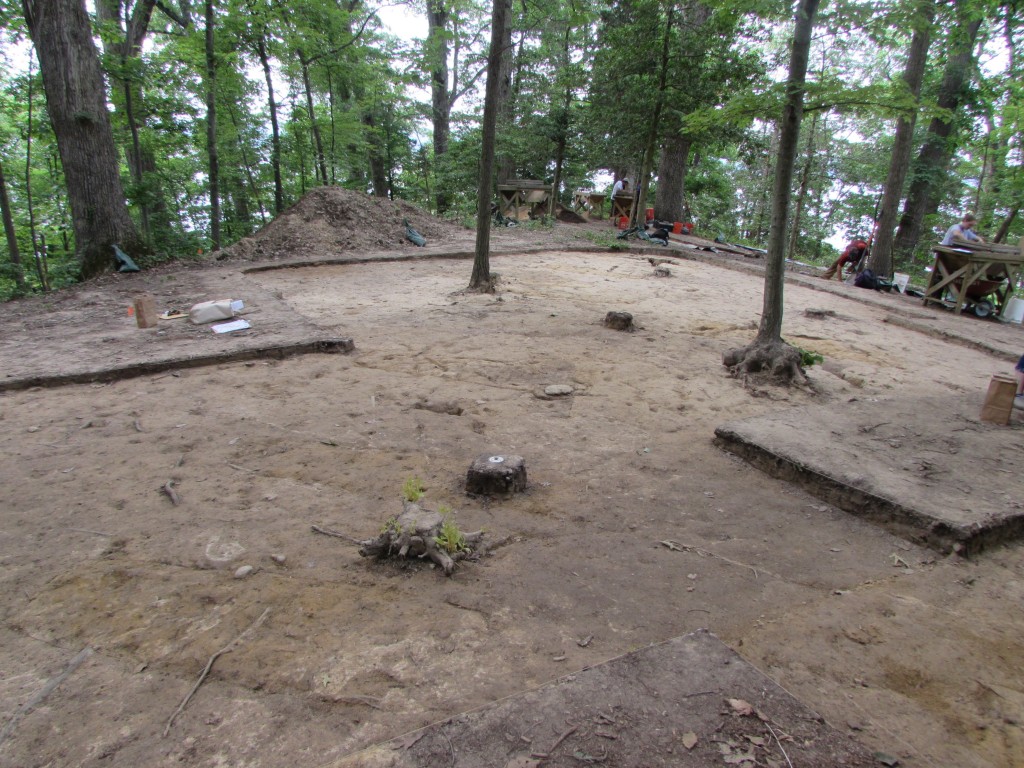
The Mount Vernon Slave Cemetery. Photo by author.
It is an aspect of slavery’s evil that can easily go unnoticed. For every William Lee—the personal attendant of George Washington whom the general mentioned by name in his will—there are countless slaves whose whole identities remain lost to us because no sources documenting their lives survive. Even the names of many slaves remain a mystery to historians, along with the hopes and dreams, frustrations and sorrows that made them full-fledged human beings. Robbed of their individuality in life by being treated as property, these human beings are robbed of it in death as well through the silences that keep us from knowing who they were and how they lived.
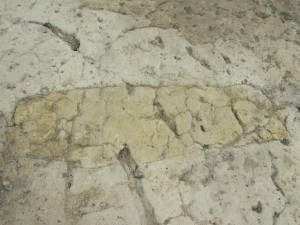
The outline of a grave shaft. Photo by author.
The goal of the project at Mount Vernon, as the project’s crew chief, Joe Downer, explains, is to reclaim as much of that story as possible. “It is a profound thing to uncover and identify a grave shaft,” Downer says. “Each outline that we see represents a single individual, someone who lived, forged relationships, made memories, and had both joy-filled and sorrowful life experiences that helped shape who they were. The fact that many of these individuals were forced to live in a system that denied them their humanity makes their story all the more powerful. I think it is compelling for visitors to see these grave sites because it forces them to think of the enslaved individual, and the enslaved community, in a way that is not possible on other areas of the estate.”
The burial site is located south of Washington’s tomb on the Mount Vernon grounds, in a wooded area at the top of a hill overlooking the Potomac. The aim of the project, Breen explains, is to determine the size of the burial site, how many graves there are at the site, and how those graves are arranged. Out of respect for the individuals buried there, no bodies are being exhumed. Instead, archaeologists and volunteers are conducting shallow digs—only inches deep into the soil—to reveal the outline of individual graves, visible because of the slightly darker shade of soil that resulted when slaves dug the grave and filled the soil back in. So far, they’ve uncovered 31 graves.
Though so much precious information about these people can never be recovered, Breen and Downer point out how much there is to gain through examining the size and layout of the burial site. Before beginning the project, the team “hypothesized that burials could have been arranged in neat, tidy rows that suggested a more controlled or planned cemetery,” Breen explains. “Or burials could be arranged in a more irregular fashion that could suggest agency on the part of the enslaved community to create a burial ground they found suitable. The other factor to consider is the passage of time and how permanently the burials were marked—this could account for a more regular arrangement as well.” As is so often the case with anthropological and historical research, the crew found evidence to support each of these hypotheses. They did find graves arranged in a general row pattern—but then they also found more that broke with that pattern.
The team is pairing archaeological techniques with historical inquiry, including an oral history project in which researchers interview descendants and the creators of the 1985 memorial on the site. They are also working with volunteers, many of them students from local schools. Volunteers on the project not only learn basic archaeological and historical techniques but also get to interpret the site for visitors to Mount Vernon, educating the public about the human lives behind the exploitative system that sustained Washington’s home. “Interpreting our project to the public is perhaps one of the most important things we do on site,” Downer remarked. “At the cemetery, volunteers are able to hone their public speaking and interpretation skills by communicating our goals and findings to various audiences and individuals of all ages.” The results, Breen added, have already been remarkable. “A group of African American visitors came by the site at the beginning of this year’s field season. After listening to one of the archaeologists interpret the site and seeing the work, one commented, ‘Well, seeing this is worth the price of admission.’ My hope is to elicit this response from everyone who hears about the project.”
Volunteers and archaeologists work on the project every Friday and Saturday through October, weather permitting. Those interested in volunteering are encouraged to visit the project’s website . And those who want to view the site can do so by contacting Eleanor Breen at [email protected] .
Nathaniel C. Green holds a PhD from Washington University in St. Louis, specializing in early US political culture. He is currently a fellow at George Washington’s Mount Vernon.
This post first appeared on AHA Today .
Tags: AHA Today African American History Public History
The American Historical Association welcomes comments in the discussion area below, at AHA Communities , and in letters to the editor . Please read our commenting and letters policy before submitting.
Please read our commenting and letters policy before submitting.

Private Guided Mansion Tour of George Washington's Mount Vernon

- Private guide
- Entry/Admission - George Washington's Mount Vernon
- Food and drinks
- Hotel pickup and drop-off
- 3200 Mount Vernon Memorial Hwy, Mt Vernon, VA 22121, USA Departure Point: Mount Vernon Ford Orientation Center Address: 3200 Mount Vernon Hwy Mt Vernon, VA 22121 Dates: Daily
- Wheelchair accessible
- Stroller accessible
- Service animals allowed
- Transportation is wheelchair accessible
- Travelers should have a moderate physical fitness level
- This is a private tour/activity. Only your group will participate
- For a full refund, cancel at least 24 hours in advance of the start date of the experience.
- George Washington's Mount Vernon
Similar experiences

- You'll start at 3200 Mount Vernon Memorial Hwy 3200 Mount Vernon Memorial Hwy, Mt Vernon, VA 22121, USA Departure Point: Mount Vernon Ford Orientation Center Address: 3200 Mount Vernon Hwy Mt Vernon, VA 22121 Dates: Daily See address & details
- 1 George Washington's Mount Vernon Stop: 60 minutes - Admission included Tour George Washington's beloved home, gardens, and learn about his remarkable life. After your hour-long guided tour, you may explore the rest of the estate, museum, and education center on your own and at your leisure. Read more
- You'll return to the starting point

- ddG9490FL 0 contributions 4.0 of 5 bubbles Lots of walking Did our own tour by buying a ticket for admission and using map and signs to walk through estate. Did not have tickets ahead of time to mansion, so arrived in morning to buy those tickets, which ended up giving us mansion time 2 hours later. Plenty of time to walk around rest of estate. Be aware lots of walking. Had someone with mobility issues so we did use a wheelchair that was available for not cost at location. It was a big help for this person, but hard for the person pushing due to a lot of hills. Be aware you can’t do the mansion if you are unable to walk upstairs. Read more Written April 9, 2024
- 374dwightv 0 contributions 5.0 of 5 bubbles Rich in history and affordable Well maintained and managed by a private group, there is more to see than just the home. Guides were pleasant and knowledgeable. The house tour isn't long but you see enough to be satisfied and the fee is very low. We also dined at the food court which was shockingly good and not RIP off priced like a lot of places that 'have you' sort of captive on their grounds. Seating is a bit limited during peak lunch. Free maps are provided and you can get an audio guide as well, but we found the signs sufficient. Some sights require walking up hills or stairs. We thought it was a great value overall. Read more Written March 24, 2024
- DMann56 0 contributions 5.0 of 5 bubbles A must see! The mansion tour is a must. All the staff were very knowledgeable, engaging, and willing to answer questions. The estate grounds are beautiful! There were several baby sheep that were only hours old, which was a bonus. The walk to the tomb of George Washington was past the house down a gravel walk. Several historic outbuildings. Beautiful views of the Potomac. Read more Written March 22, 2024
- stylebyjax 0 contributions 5.0 of 5 bubbles A must-see of the first president home This was my first time visiting DC. I was visiting my son, who was recovering from an injury during deployment. We took advantage of this opportunity and explored it. My must was to visit George Washingtons' home. I had no idea how huge the grounds were. I love seeing how they preserved the house and estate. It was a fantastic experience. Expect it to be busy, but it's a must-see. Read more Written March 17, 2024
- C1517OCjaneh 0 contributions 4.0 of 5 bubbles Well-curated, but timed tickets a joke Grounds were lovely and the site was well curated with lots of historical info, sensitively portrayed. However, we purchased timed tickets to enter the residence and didn’t actually enter until 45 minutes later. We were standing in a long line waiting. Why have timed entry if we have to wait? MV should take tips from Monticello (Jefferson’s home) for doing it right. Read more Written March 17, 2024
- edmundp2015 0 contributions 4.0 of 5 bubbles Throngs of disaffected youths 1/2 day at Mount Vernon. Arrived first thing as they opened the gates. We were met by throngs of middle schoolers and high schoolers with many chaperones. Most of these kids were more interested in how their hair looked than the exhibits. Going over spring break might not be the best idea…. One could easily spend the whole day exploring the grounds and amazing museums. The 4D movie about the revolutionary war was really engaging. Great gift shops. Lovely grounds. Read more Written March 14, 2024
- OccasionalTrav49 0 contributions 2.0 of 5 bubbles Mansion tour poorly done Disappointed in crowd management on a Friday morning. 10am mansion tour we booked and rushed to get to on time. Only to wait 30minutes behind multiple school groups. Why offer tour times if you cannot honor them. Shouldn’t have individual and school groups booked together. Loud and lots of shouting. Would have liked an actual historic tour with a guide walking small groups through. Expected better tour management instead of being herded like cattle in a long line through the house with very little information. Wasn’t able to learn much bc it was just horridly managed. I think I got to hear guides say one paragraph. Have toured multiple historic homes that are popular and this was managed the worst. How embarrassing for what should be a well oiled machine. My recommendation is just tour the grounds and skip the mansion tour. Look at photos of the rooms in a book bc that’s about as much as you’ll get out of it. Read more Written March 8, 2024
- geezergal55 0 contributions 2.0 of 5 bubbles DISGRACEFUL We visited today, March 7, & were shocked at the number of school children on tours there. This would not have been a problem if the teachers had any control over their students but NOT! Children ran wild around the grounds & through the museum, screeching, banging into us & literally assaulting the exhibits! Shameful. I was a grade school teacher myself & there's no excuse for allowing children to behave in a manner so disrespectful & lacking in any discipline or interest in learning about our founding father. Why bring them there at all? When you visit be sure to avoid school holidays, we were told that September is the best time for that. Read more Written March 7, 2024
- legalpike 0 contributions 5.0 of 5 bubbles Amazing learning experience. This was far better than expected. The home is beautifully preserved. The grounds are really well done. It kept my teens attention and they learned a lot. Very glad we took this detour during our trip. The museum is a must see as well. Read more Written February 19, 2024
- jschro9 0 contributions 3.0 of 5 bubbles Room for Improvement Exploring the grounds is similar to learning about any plantation from the time period. The tour materials are poorly organized: 2 separate brochures - one original and one focusing on the enslaved people who lived there - and then an audio app for your phone, as well as signs at each spot. The text was different at each spot, so there wasn’t a flow or story that developed through the self-guided tour. We paid for timed entry tickets to the mansion, but still waited 45 minutes to enter. I’m certain during high season it is much longer. The staff was posted at various locations to give additional information but seemed bored and apathetic about the information. They said “ask me any questions,” but didn’t share much information on their own. The renovations meant that the mansion tour was brief but slow. People shuffle through in a crowd and peek your head into a room. Most of the artifacts are NOT original but are recreations. This is due to the history of Mount Vernon falling into disrepair after Washington’s death, but we only learned this at the end of the tour as we walked down a hallway connecting the grounds to the parking lot. Overall, it is interesting if you like to experience that time period, but the George Washington specific information is minimal and not well-designed. It’s a 45 minute drive from DC and takes about half a day. Consider carefully if it’s worth your time. Read more Written February 19, 2024
- mmgohoos 0 contributions 4.0 of 5 bubbles See the Home of One of the Greatest American's Ever This is a great place to go and see the home of one of the greatest American's to every live. But BEWARE... There is a MAJOR renovation going on and not all parts of the mansion are accessible. The "New Room", the largest room in the mansion is being renovated and is not part of the tour. Overall there are stunning views of the Potomac River and you still get the chance to see around the vast plantation, including gardens, and Washington's tomb. Even with the renovation project this is a great place to visit. Be sure to allow plenty of time and don't rush through this. The mansion tour was not bad, I felt like our guide did not interact with us much and simply went through the motions at times. However, it was still very interesting to see inside the mansion. Read more Written February 7, 2024
- 175wardd 0 contributions 5.0 of 5 bubbles This place is wonderful and full of history! Highly recommend it to everyone There is a lot to see at this place. The staff was wonderful, patient, and knowledgeable about history, in general, and the site, specifically. This is a restored home and ground of George Washington. There is a parking lot to the north side outside the gate. I think on many days that this is enough parking for the site. There is a fee for entering but it is well worth it as there is so much to see and so much history to be learned from this site. There is an entry building called the Ford Orientation Center that has lovely displays and a running movie telling the history of the site. The grounds are very well maintained and include a garden, mansion, tomb, Slave memorial, and wharf. You enter at the top of the hill and getting down to the wharf is a long walk with a good slope. They are refurbishing many of the structures on site but you can look inside many/most of them to see their purpose and items. The views are spectacular from the mansion and the walk around the site is very peaceful. I plan to visit again and bought a year-round pass to explore more things in the future. I highly recommend this historical place to all my fellow travelers and history lovers. Read more Written January 22, 2024
- Razorfish 0 contributions 5.0 of 5 bubbles Great educational mansion tour and visit to the grounds of Mount Vernon This past July I visited Mount Vernon with my wife, daughter and three grandsons. We had a great educational mansion tour and visit around the grounds. It was fascinating to see how Mr. and Mrs. Washington decorated the mansion. The grounds reflect the outbuildings that were needed to operate the farm. It was also enlightening to see the slave quarters with its bunks. I’m glad my grandsons got to see the first president’s home and got an idea about the operation of his farm. Read more Written January 17, 2024
- jvc2 0 contributions 3.0 of 5 bubbles Good, but Overall it is great history and great for our country. I saw many people who were obviously from other countries that may be coming to live in America and they damn well need to learn about the greatness of our country and Mt Vernon is a great way to start. One bad situation; in the museum this mall cop sort of security jerk was terribly rude/impolite to me. I chose not to fight it there as it is foolish to do so. But He made the trip for me and my family much less pleasant. Taller (maybe 6'2" white male in a black security outfit) Read more Written January 11, 2024
- koz1031 0 contributions 5.0 of 5 bubbles Awesome House and Property at Mount Vernon! Great location to learn some history and see how our ancestors lived. House was beautiful and grounds were well kept. Wish more extra options were open/ available. Read more Written January 2, 2024
More to explore in Mount Vernon

Most Recent: Reviews ordered by most recent publish date in descending order.
Detailed Reviews: Reviews ordered by recency and descriptiveness of user-identified themes such as wait time, length of visit, general tips, and location information.

Buy it with


COMMENTS
Mount Vernon was a thriving plantation because 318 enslaved people working sun up to sun down in bondage to George Washington. George Washington profited from this system of enslavement throughout his life, and, despite private letters suggesting a shift in attitudes, only arranged to free those he enslaved after his death. In an hour-long tour:
By Sudie Hofmann At the time of George Washington's death, the Washingtons enslaved 318 people of African descent at Mount Vernon, according to the Mount Vernon Ladies' Association. But you would not know it from the main tour, nor from the brochure. In fact, most visitors, including schoolchildren, can spend hours admiring the Mount Vernon mansion, fine furniture, and manicured lawns without ...
901 E. Cary St. Suite 900. Richmond, VA 23219. Industry. Media. This 60-minute guided walking tour highlights the lives and contributions of the African-Americans who built and operated the plantation home of George and Martha Washington. In 1799, more than 300 slaves lived and worked on the five farms that made up Washington's 8,000-acre ...
The West Front of Mount Vernon, by Edward Savage, 1787-1792 Mount Vernon Ladies' Association. Bequest of Helen W. Thompson, 1964 Bequest of Helen W. Thompson, 1964 You are dining with the President.
This marker in the slave cemetery was placed in dedication by the Mount Vernon Ladies Association in 1929. Notice the outdated language describing the enslaved people. Tyrone Turner/WAMU hide caption
After my mansion and slavery tours, I spent a long time wandering Mount Vernon's vast grounds and learning about farming, blacksmithing, aquaculture and livestock on Washington's estate.
The evolved enslaved people tour of George Washington's Mount Vernon estate focuses on mutual transformation of owner and possessed, reveals sexual liaisons between gentry and enslaved women, and more. ... Dance movement therapist helps kids. Maintaining bird boxes in Wissahickon meadows. Slave Tour of Mount Vernon Evolves December 30, 2019.
Perhaps the most valuable written records of the enslaved community at Mount Vernon are the slave inventories that Washington completed in 1786, after he had returned from the Revolutionary War, and in 1799, as he created his last will and testament. In both sets of lists, Washington named each person on his five farms and gave an idea of their ...
Half-hour walking tours introduce guests to the 316 slaves who lived at Mount Vernon at the time George Washington died in 1799. The mansion farm was home to about 90 of them. During the past 20 years, as interest has grown in slave life, Washington's meticulous records and archaeological digs around the estate have changed some perceptions ...
3200 Mount Vernon Memorial Highway, Mount Vernon, VA 22121 (703) 780-2000 www.mountvernon.org Mount Vernon is approximately a three-hour drive from Hampton Roads.
The Association purchased Mount Vernon from George Washington's heirs in 1858 for $200,000 with the goal of saving the estate and preserving its history. It was a daunting task. But the ...
In 1983, architecture students from Howard University added an updated memorial to the Slave Cemetery to honor the enslaved people who were forced to spend their lives toiling at Mount Vernon. MountVernon.org. Mount Vernon Inn Restaurant. While you can certainly dodge scores of school children and opt for a fast-food style meal at the Mount ...
Now, Monticello's guides, called "interpreters," tell their nearly half a million visitors a year about "enslaved people." "Slave" is a noun, Ronka said as other tour groups ...
During the Enslaved People of Mount Vernon Tour, history interpreter Jessica Obert tells stories, sometimes disturbing, about the men, women and children who were held in bondage. Matt Briney ...
At the commencement of the Mount Vernon archaeology department's multi-year Slave Cemetery Survey project, Reverend Darrell Keith White urged visitors to George Washington's plantation home to recall the "unnumbered trail blazers who rest beneath this hallowed space." Eleanor Breen, deputy director for archaeology at Mount Vernon, recalls Reverend White's words when she discusses the ...
About. Get a VIP look at George Washington's 21-room residence as you're led through the mansion by a private guide. During this 1-hour private walking tour, you'll go behind-the-scenes as you hear expert commentary about the United States' first president and his historic estate. This tour includes some of the gardens and grounds.